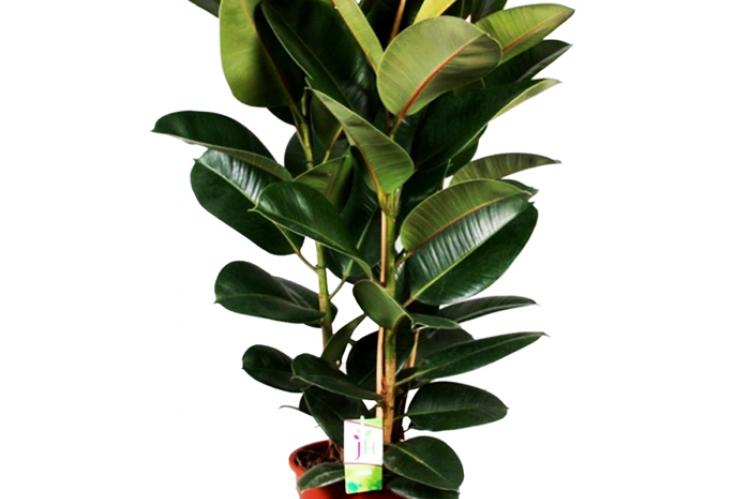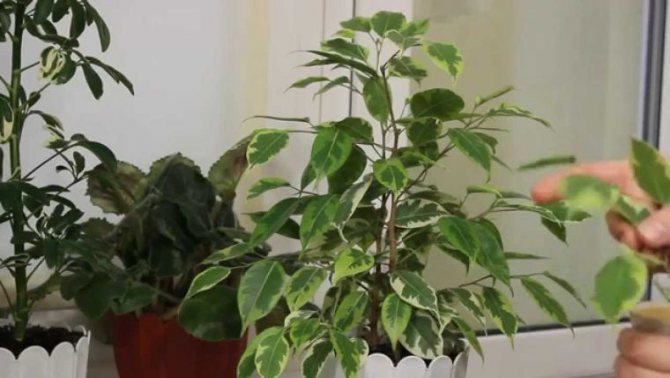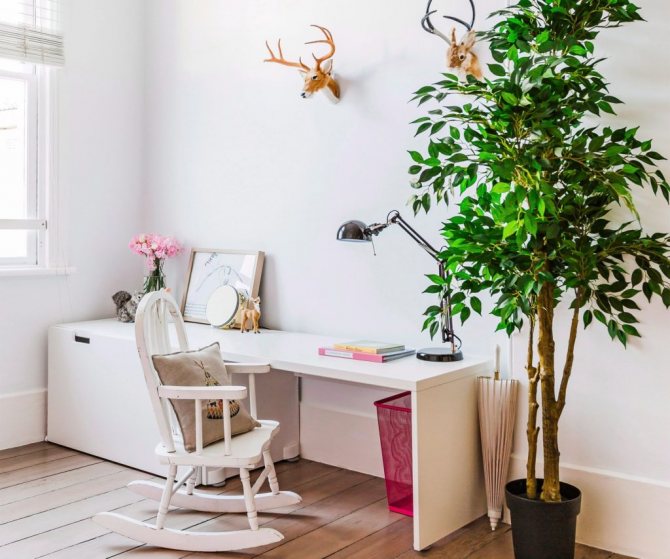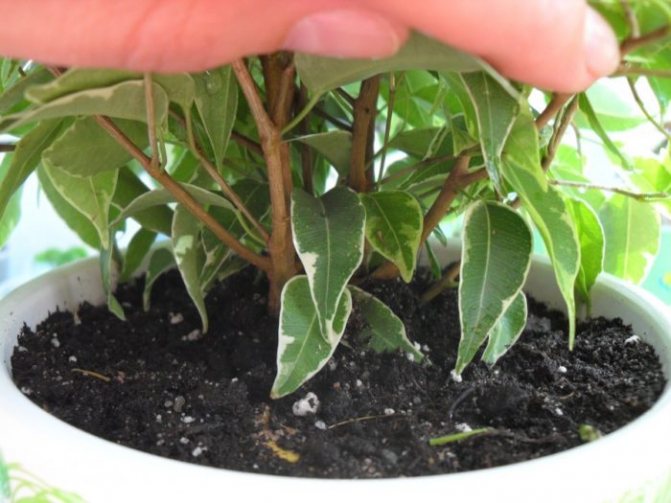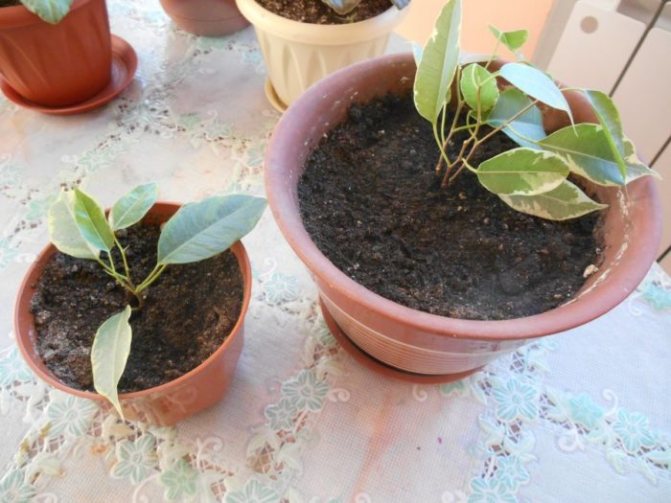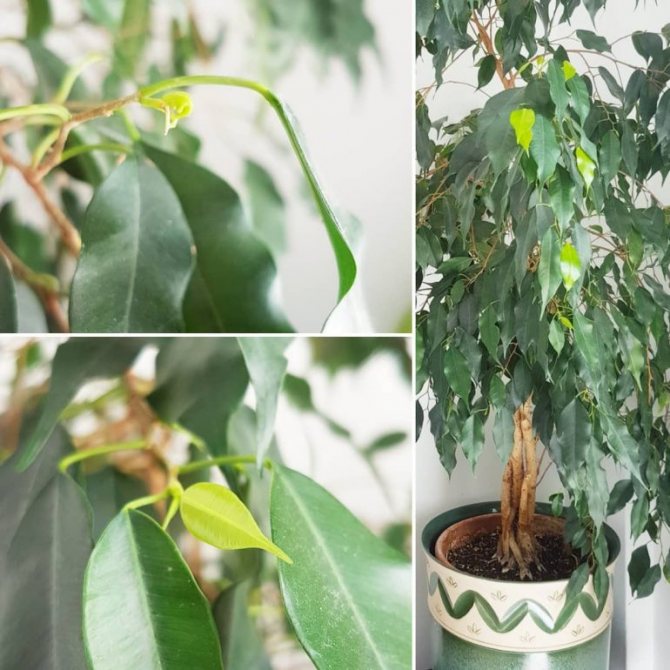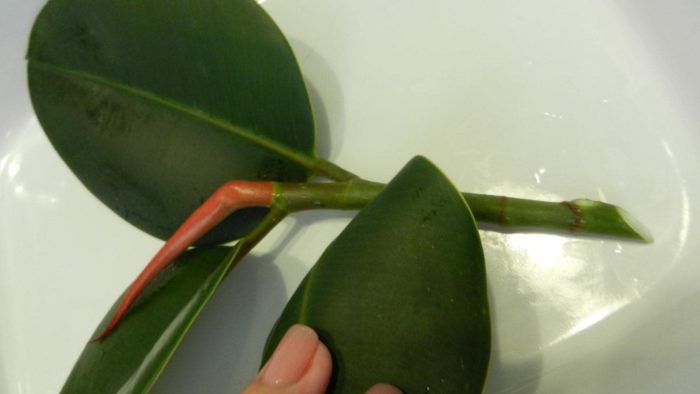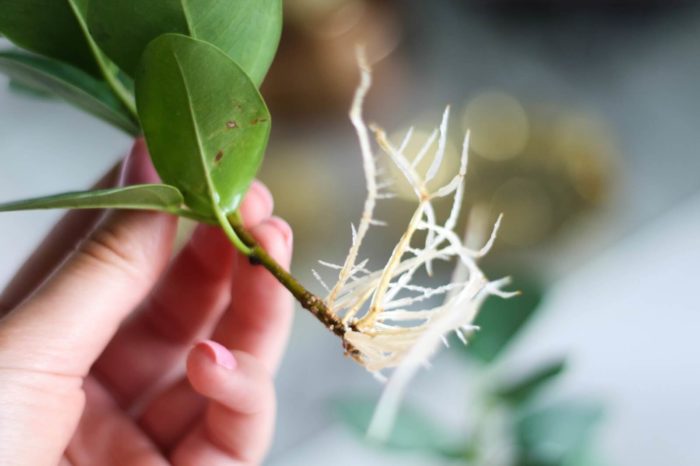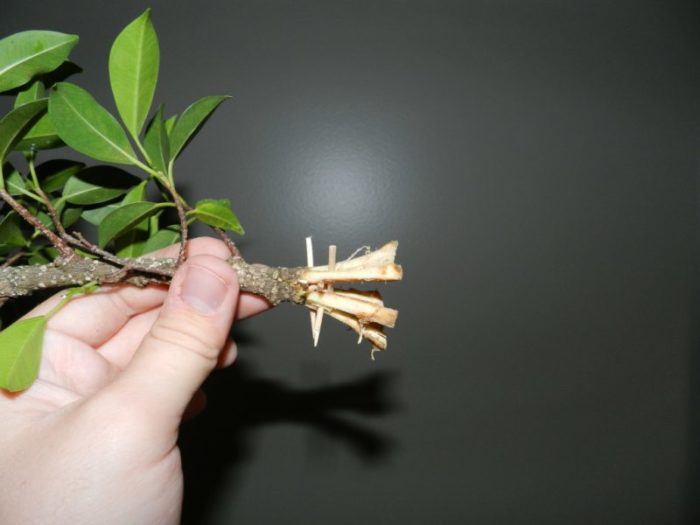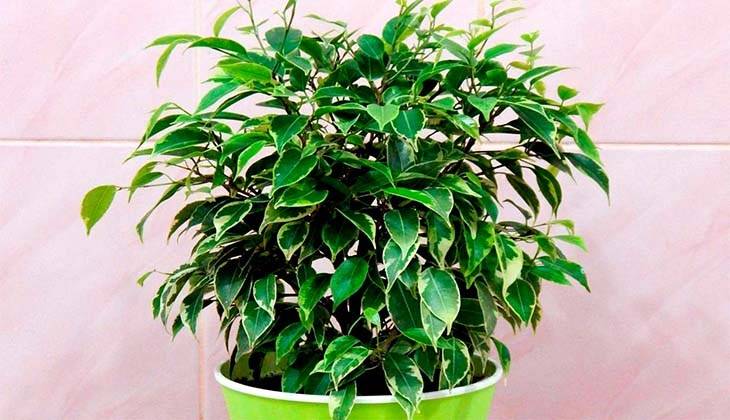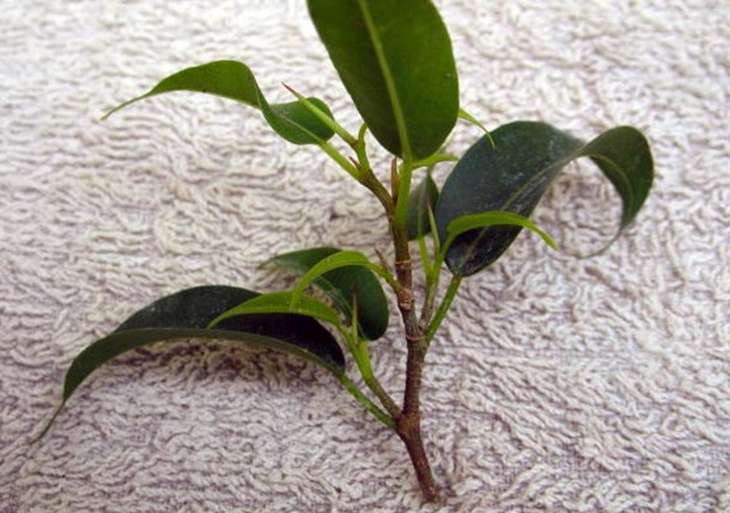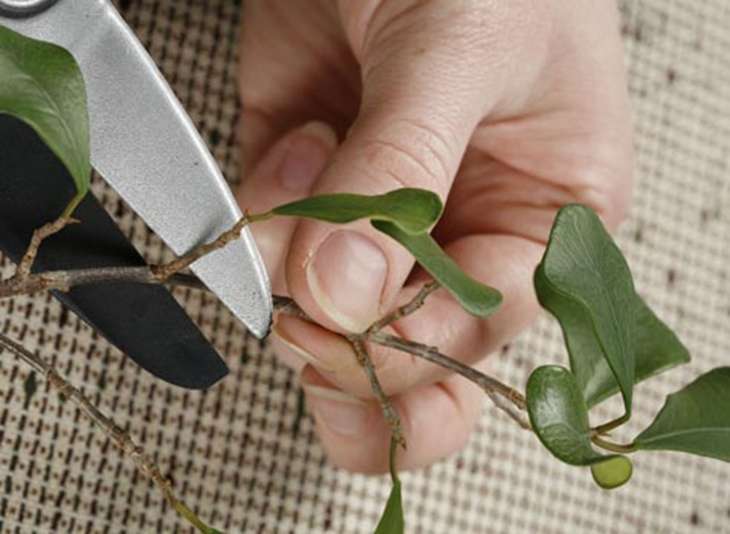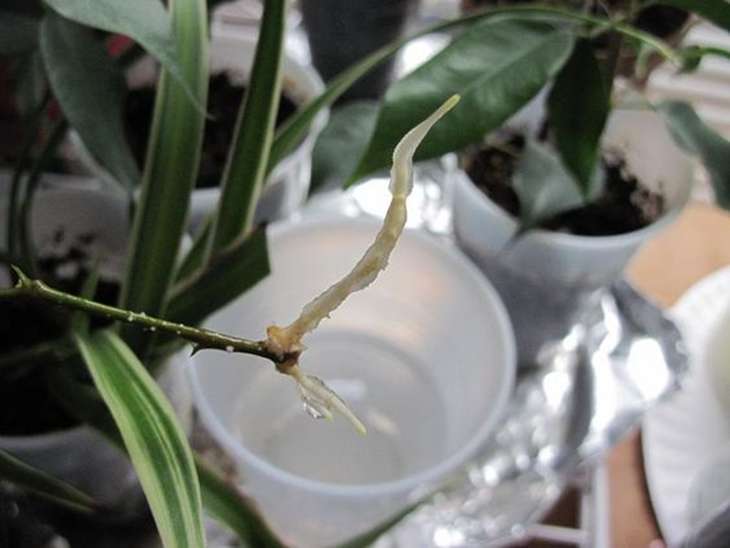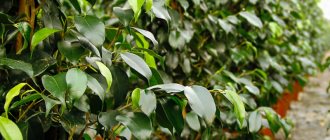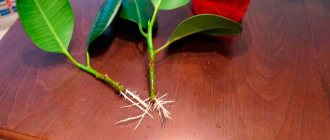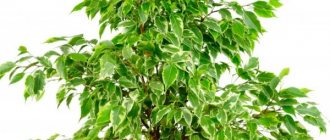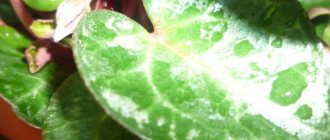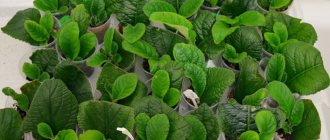All ficuses are hardy and very tenacious. Their shoots, in contact with the soil, form roots and give life to new plants. Aerial roots, descending to the ground, provide additional nutrition for the growing crown. Even the unusual shape of the fruit seems to be designed so that the birds eating the flesh will gnaw and then settle the seeds.
But how to propagate Benjamin's ficus at home? Are there any peculiarities and pitfalls here? Plants of this species reproduce vegetatively without complications. The most common method is cuttings, which is how most plants are propagated. Among them are hibiscus, lemon.
Description of the plant
In the wild, Ficus Benjamina reaches 25 meters in height, in an apartment - no more than three. It is an evergreen perennial with a developed root system. At the same time, the roots are quite fragile, which must be taken into account when transplanting a plant.
The flower makes its foliage decorative, which can be variegated or monochromatic. Ficus leaves with a delightful glossy overflow, very smooth, depending on the variety, they grow in length from 4 to 12 cm, in width - from 3 to 6 cm. They are located on the stem alternately and are formed in the same plane.
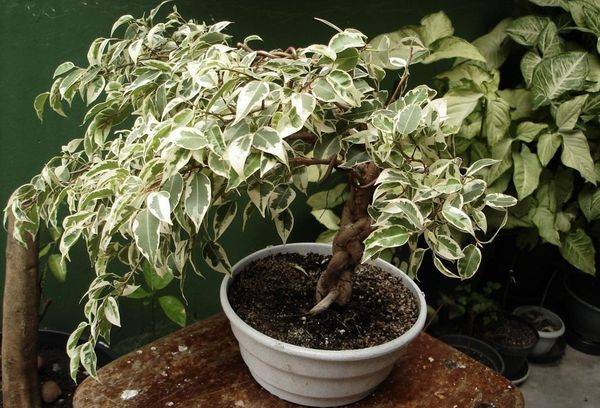
Ficus Benjamin has a gray bark with rare brown blotches in the form of strokes, a wide crown and drooping branches. The fruits of the plant are orange or red, oblong or round, paired, approximately 2 cm in diameter. They cannot be eaten.
The flower fits perfectly and adorns any interior, therefore it has become widespread in phytodesign, indoor floriculture, and landscaping.
The ways
Ficus Benjamin is a unique plant with the ability to quickly and efficiently clean the air in the room. From the environment, the flower absorbs chemical compounds harmful to humans: phenol, benzene, ethylene and others. After being absorbed by the smart plant, these harmful substances are decomposed in its body into amino acids and natural sugars.
To propagate a plant at home, you can use the following methods:
Immediately, we note that it is not customary to propagate this plant with seeds at home - the process is too long and complicated. Most growers choose the grafting method, sometimes cuttings are also used. Further, we will consider in detail all the listed methods.
Reproduction and planting
At home, Benjamin's ficus is propagated by cuttings, and the best time for this is March-April.
Tip You cannot use scissors for cutting cuttings, as the blades squeeze the twig strongly when cutting, which is why the bark partially peels off. This slows down rooting.
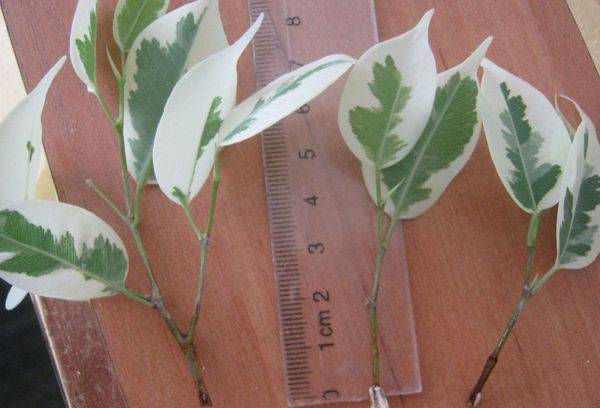

How to propagate a flower:
- Use pruning shears to cut the cuttings 10 to 20 cm long from lignified mature twigs. Immature green cuttings cannot be rooted, as they rot and die from a long stay in water or substrate.
- Rinse off the milky juice that appears on the cut with warm water or remove it with a soft cloth.
- Cut the cuttings along the stem with a very sharp knife, separate the formed parts with toothpicks or matches. This technique will stimulate root formation.
- Place the cuttings in water, peat tablets, or substrate. Add 1 tablet of activated charcoal to the water used for rooting and replace the solution frequently with fresh one. To prepare the substrate, take an equal amount of sand, leafy and sod land or peat and chopped charcoal.
- The magazine "Miss Purity" recommends, to stimulate the formation of roots, add succinic acid or 1 tablet of "Kornevin" to 1 liter of water and soak the cuttings in the solution for 12-20 hours.
- Roots will appear 2-4 weeks after propagation by cuttings, if the air temperature is 20 ° C or higher. To speed up the process, set up a greenhouse or cover the cuttings with a large plastic bag.
- After the roots have grown a few centimeters, transplant them into permanent soil.
- In the first weeks, cover the seedlings with a bag until leaves appear on the plant.
Video "Methods for breeding ficus Benjamin"
Ficuses reproduce well with the help of aerial roots. This is an especially good method if the indoor ficus has almost ceased to produce young shoots and its rough branches are not suitable for conventional cuttings. The plant must be healthy and strong in order to propagate with an aerial shoot.
Since in this case we have to root Benjamin's ficus before separating the stalk from the mother plant, we first need to outline a place for future roots. In this case, the branches can be large branches.
A circular notch is made on the trunk at the selected place of the home ficus, or the bark is cut off. The wound should be disinfected with activated carbon, and then treated with a growth stimulant. This can be done with a cotton pad. Further, sphagnum moss is applied to the place of the cut or notch - this is an excellent medium for small roots, moreover, protecting them from rot.
Now we grow the roots on home ficus - for this you only need to periodically moisten the moss (as it dries, it becomes lighter). After about 2 months, the roots will completely braid the moss and become clearly visible under the film. After that, the new shoot can already be cut (under the root system, of course) and start planting it in a soil suitable for ficuses.
As you can see, it is not so difficult to deal with the reproduction of ficuses. Observe the necessary conditions, do not forget to care for cuttings and layering, and soon you will receive the desired amount of healthy young plants.
In this video, you will learn about how you can propagate the Benjamin variety at home.
Ficus is one of the popular houseplants used to decorate the interior. Intense shoot growth and bright green foliage will transform a room for any purpose. Culture looks great in a small apartment and a large country house. The exotic handsome man conquered the hearts of flower growers not only with high aesthetic qualities, but also with undemanding care.
The flower is easy to propagate using one of the available methods. It is better to plan these events in the spring or summer. There is a dormant period in the fall. Until the onset of spring, the plant rests, gains strength. At this time, the release of new shoots and foliage is reduced. You should not injure the ficus by cutting cuttings or leaves, there is a high probability of a weakening of the protective function.
In this video, an expert will tell you how to properly propagate Benjamin's ficus.
Transfer
Transplant young ficus every spring, adult plants once every 2-3 years.Transfer the flower carefully into a large pot as the root system is fragile. For the first 2 weeks after transplanting, the leaves may fall off the plant. Change the top layer of soil to fresh one annually at the tub tenants.
You cannot transplant a purchased ficus from a shipping pot to another immediately. For a plant, changing its location is stressful, it must adapt to the microclimate of the room. Therefore, transplant the purchased ficus only after 2-3 weeks.


When to transplant:
- the soil of the transport pot is not suitable for permanent growing of the plant, so it must be transplanted;
- if roots come out of the drainage hole, this indicates that the pot is small for a flower;
- when the soil is affected by pathogens or fungi.
It is necessary to transplant Benjamin's ficus for the first 4 years of life annually, starting at the age of five - once every 2-3 years. Renew the topsoil in the pot between replants.
Transfer rules:
- The new pot to be transplanted into must be 3 cm taller than its predecessor.
- The optimum soil for growing is leafy and should have neutral acidity (pH). Flower shops sell special soil for ficuses.
- Be sure to place a drainage layer on the bottom of the pot.
- Do not peel the roots from the ground when transplanting, as they are very fragile and the slightest damage will affect the growth of the flower. Use transshipment.
- Water the plant after transplanting no earlier than two days later.
Reproduction by layering


Ficus Benjamin is able to reproduce not only by cuttings, but also by layering. This breeding option is resorted to in the following situations:
- the plant rarely forms young shoots, but lignified adult stems are abundant;
- the desire to get a bonsai-ficus, which has many aerial roots (cuttings) hanging from the shoots.
On a lignified shoot or branch without touching the wood, a ring-shaped cut is made on the bark. It needs to be treated with a growth stimulant and wrapped in wet sphagnum moss, which is covered with a film. The latter is fixed with thread, tape or wire.
It is necessary to detach the cutter from the mother plant only after the formation of roots. You need to cut it below the root system. Further planting of a young seedling is carried out according to the traditional scheme. A cut on an adult flower, which remained after removing the layer, should be sprinkled with ground coal or treated with garden pitch.
This method is more complicated than the previous one, but it is also quite applicable. Layers are called ordinary aerial roots. The method is irreplaceable if the ficus is old, completely lignified and is not suitable for grafting.
On the lignified shoot of the mother plant, you need to cut the bark in the form of a ring (see photo). Cut carefully to avoid damaging the wood too deeply.
The bark-free area of the plant is treated with a root stimulant, covered with peat, moss or peat soil soaked in water. All this is fixed with a waterproof transparent film, fixed firmly.
Moss the moss / peat periodically to create favorable conditions for root germination. Usually two months pass from the moment the bark is cut until the shoot is ready for planting.
The sprouted roots can be seen directly through the film. When this happens, the shoot with roots is separated from the mother plant, planted in a separate pot. Do not forget to treat the cut on the donor plant with activated charcoal or charcoal. It can also be processed with garden varnish.
Interesting: the method of propagation of ficus by layering is used by bonsai specialists to get miniature trees of unusual shapes.
Lighting
The growth and development of the ficus depends on how good the lighting in the room will be.An insufficient amount of light, especially for varieties with variegated leaves, will lead to the fact that the flower will gradually lose its decorative effect and its growth will slow down.


Excessive lighting is also undesirable, as it can provoke yellowing of the leaves and the occurrence of burns on them.
If there is a lack of sunlight in the winter months, carry out supplementary illumination with phytolamps. In the summer, place the flower pot on a balcony, loggia, or windowsill located on the east, southeast, or west side of the house. On hot days, it is best to place Benjamin's ficus in partial shade outdoors.
Tip Do not move the plant pot too often. This can provoke leaf shedding.
Seed method
You can also propagate Benjamin's ficus in an apartment with seeds. However, at home, this method is poorly implemented, since it requires a significant investment of time and effort from the grower. Many experts argue that only seeds can grow a really strong and healthy flower.
You can buy seeds from a flower shop or from a plant that has faded. For seed germination, use a special soil consisting of the following components in equal proportions:
- deciduous land;
- peat;
- sand.
To accelerate pecking and root formation, it is recommended to treat the planting material with a growth stimulator. Processing is carried out immediately before sowing.
The prepared seeds are sown in moist soil. It is necessary to deepen them by about 1 cm. From above, the seeds are covered with soil. The container into which the seed was planted is covered with foil or transparent glass. As a result, a greenhouse effect is created inside.
The seed pot must be placed in a warm place. Periodically, the film or glass is removed and the ground is ventilated. This action avoids the formation of mold inside the homemade greenhouse, and also protects the seed from rotting.
When the first shoots appear, the glass or film is removed. Transplanting into separate containers is performed after the sprouts reach 4 cm in length. After the formation of a healthy and strong seedling, it is transplanted into a full-fledged flower pot.
Reproduction of Benjamin's home ficus is possible in various ways. Each method has its own characteristics and rules. Only by following them can you independently grow a new plant at home.
This method is used less often than others, since it is rather dreary and very long.
It is usually customary to propagate ficus seeds only in conditions of breeding stations for scientific purposes - at home there is no need for such troubles. However, if you have free time and are determined to try to grow a ficus from a seed, we will give some important instructions on this matter.
Before being placed in the ground, the seeds must be treated with a growth stimulant - this way they will sprout more readily and faster. Do not forget about fungicides - it is important to protect plants from damage by pests and diseases.
The seeds are sown in light, nutritious and well-moisturized soil. The container is placed in a warm place, covered with polyethylene on top. Thus, with constant ventilation and spraying of the soil, you should wait for the germination of seeds.
Priming
The soil for growing Benjamin's ficus must be moisture-permeable, fertile, with an increased degree of aeration. Acidity - slightly acidic or neutral (pH 5.5-6.5). The composition of the primers purchased at the flower shop differs depending on the manufacturer. The main components in them are peat, sand, complex fertilizers, humus, expanded clay. If you buy all-purpose soil and add equal amounts of sod and leafy soil to it, you get an excellent soil for Benjamin Ficus.
Seed propagation
Seed propagation of ficus is quite rare.There is a lot of trouble with growing seeds, and you can't get seed on your own. At home, the seeds of Benjamin's ficus do not ripen and the plant cannot be propagated. Of course, you can buy Benjamin ficus seeds in the store.
Seed propagation has the following advantages:
- New plants are healthy, the characteristics of the variety are fully transferred to the seedlings.
- A large plant with a thick trunk is obtained only from seeds.
Growing seeds
First ficus seeds are soaked in a special preparationwhich stimulates the growth of a new plant. Soaking is carried out for one hour. While the seeds are soaking, prepare the soil mixture. It should consist of leafy earth, peat and sand. Ready-made soil of industrial production, specially designed for ficuses, is also suitable. The soil is transferred to a container, watered and tamped. Seeds are laid out on the surface, keeping a certain distance between them. The seeds are covered with one centimeter of soil, compacted and watered.
The surface of the container is covered with foil or glass. If a film is used, then it is glued to the container with tape to create a seal. This design will not allow moisture to evaporate quickly.
Periodically, the container is ventilated and watered. As soon as the seeds germinate, the film is removed. Young ficuses are protected from drafts, drying out of the soil and direct sunlight. When the seedlings have grown to 4 centimeters in height, they are transplanted into separate pots. Care and conditions are carried out as for adult plants.
Humidity and watering
In the summer months, spray the crown with boiled water, since after the usual high hardness, whitish stains will remain on the leaves. Excessive watering of Benjamin's ficus is unacceptable.
Watering is the main component of plant care and depends on the individual characteristics of the flower and growing conditions. How often you need to water depends on the season, air humidity, age of the ficus, room temperature and light conditions.


In summer, be guided by the degree of drying out of the earthy coma - the soil should be dry at a depth of 2-3 cm. In winter, reduce the number of waterings, but do not allow the soil to dry out completely.
Tip The pot should have drainage holes through which excess moisture will flow, drain the water from the pan.
Water the ficus with settled or boiled water, which should be at room temperature. Give the flower a rain shower every 3 weeks. Place the plant in a tub, cover with plastic wrap and water for a few minutes with a warm stream of water. Do not remove the plant from the bathroom right away, as it can become overcooled due to the sudden temperature changes.
Breeding features
The tools used to work with the plant must be sterile. For this, the cutting part is treated with an alcohol solution or other antiseptic. If the cuttings are harvested from different bushes, then after each flower it is necessary to disinfect. This will prevent healthy flowers from becoming infected.
In the ground
For rooting in the soil, a substrate is prepared from turf soil, sand and peat. All components are disinfected in the oven by heating. After that, they are mixed and introduced into the planting container.
The shoot, after cleaning from the milky juice, is buried in the soil mixture by 2-3 buds. The soil is lightly compacted and moistened with a spray bottle. To create a greenhouse effect, sticks are installed along the edges of the container, a transparent plastic bag is fixed on top of them. The frame should be higher than the planting material. A warm environment and moderate humidity is required for successful rooting.
In water
Rooting cuttings in water is considered less troublesome. It is enough to put the workpieces in a container with liquid.The container should not transmit light, therefore, when using a glass vessel, flower growers wrap the outer wall with foil or a dense dark cloth. It is also necessary to build something like a greenhouse on top of the handle. The simplest option involves fixing a plastic cup.
When rooting the cuttings in water, the microclimate is set close to the natural habitat of ficuses. This is a temperature within 25 ° and an average humidity level.
Maintenance of an impromptu greenhouse is minimized:
- 2-3 holes are made in the bottom of the plastic cup for free air passage;
- as the water evaporates, make gravy;
- after the appearance of the roots, the structure is dismantled for the subsequent transplant of the shoot.
Top dressing and fertilizers
Once every 2 weeks in spring and summer, feed Benjamin's ficus with universal fertilizers designed specifically for ficuses or ornamental and medicinal plants. For example, Agricola complex, REASIL, Pokon or Bona Forte.
When choosing a mixture, consider the amount of nitrogen contained in it, which should be higher for feeding in the spring and summer and lower in the winter months.
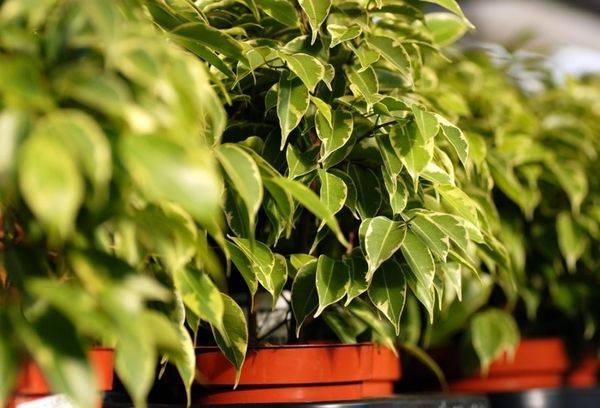

From September to March, it is not recommended to feed the ficus.
In March and April, feed the flower once a month, in May - once every 3 weeks, in the summer - once every 2 weeks. For feeding, not only universal mixtures purchased at a flower shop are suitable, but also bird droppings, ash, sapropel.
Cuttings
This is the most popular option in indoor floriculture. Propagation by cuttings does not require much time and is not too troublesome compared to other methods. On top of that, grafting ficus in most cases leads to a successful result.
What time to choose
It is recommended to cut Benjamin's ficus in the spring. Earlier summer is also suitable - during this period the flower grows in the most active way. The choice of the spring-summer period is also justified by the fact that there is a lot of time before the cold weather: the ficus will have time to properly take root and get stronger.
Cutting preparation
The stalk must be cut from a healthy mother plant: the apical part is usually taken. Shoot size - 15 cm, its base should be semi-lignified. The stalk should have 4 to 6 leaves - fully expanded. A completely lignified stalk will not work, since it will not be able to release roots: such an shoot can only be propagated by layering.


If there is no possibility or desire to touch the top of the donor plant, you can get cuttings from the side shoot. The main thing is that the shoot has a leaf and a full-fledged axillary bud.
When cutting, milky juice is released, which must be immediately blotted with a napkin. Then it is necessary to cut off the leaves located below - when soaked in water, they risk rotting. Cuts must be done obliquely.
Important: only cut the cuttings with a knife, not with scissors, as scissors can make the cut fringed, unsuitable for rooting, and prone to decay.
Rooting
The roots of cuttings can be grown both in water and immediately in the ground. If the first method is chosen, the cut part of the shoot is immersed by one third in settled water at room temperature. To prevent decay, it is recommended to add an activated carbon tablet to the water. A jar of water is placed on a well-lit windowsill, adding new water as it evaporates.


Choose an opaque container, otherwise microorganisms will quickly begin to multiply in the water. Experienced growers, in order to control the process of root growth, put the ficus in a small transparent container, which in turn is in a large opaque one, also filled with water. The cutting is ready for rooting, the roots of which have grown by about 3 cm. This usually happens after a month.
Although the growth of roots in water is practically guaranteed, when planted directly into the ground, the root system of the ficus turns out to be much stronger and more durable. But the rooting itself occurs a little less often.
To root the cutting in the ground, a mixture is taken, consisting of:
- peat;
- ground charcoal;
- river sand.
Or you can purchase a ready-made ficus substrate sold at a flower shop. It is important that the soil is moist, but in moderation.


Being in water or in the ground after 2-3 weeks, under favorable conditions, the cutting takes root. In order for the shoot to take root faster, you can make several cuts on the lower part of the bark - thanks to such cuts, the plant reproduces much more readily, quickly releasing roots.
Make sure that the lowest point of growth of the cutting is underground, and not on its surface. And if you want the roots to appear faster, build a mini greenhouse by covering the cutting on top with a plastic bag. From time to time, polyethylene must be unwound so that the handle can "breathe".
Landing in a permanent place
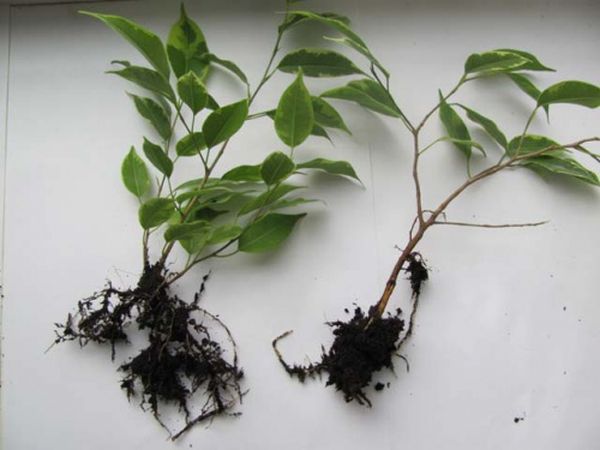

After regrowth of the roots, the ficus seedling must be placed in a container with permeable, loose and nutritious soil. After planting, for the first few days, it is better to cover the plant with polyethylene to create more favorable conditions for its adaptation. Remove the bag when new leaves appear on the seedling, which means that the plant has taken root, and the cuttings have been successfully completed.
Important: if the roots have time to grow out and become too long, it is recommended to cut them to about 3 cm before planting.
Pruning
In order for a beautiful fluffy crown to form, periodic pruning of the ficus is necessary - in spring and summer. Old plants need a rejuvenating haircut, thanks to which new young shoots grow from the axillary buds. You need to prune the branches depending on what kind of crown you want to get, but no more than a third.
Thinning the crown inside the plant will help the leaves get enough light.
Tip To make the plant unusual and give it a more attractive appearance, plant several ficuses in one pot, twist their trunks into bundles or make braids using trellises and clamps.


How to propagate ficus by cuttings?
This method is the simplest and most popular one. From one branch, you can get several cuttings at once, and therefore new plants. Moreover, the cuttings can be rooted in water or in the ground.
Harvesting cuttings
As cuttings it is worth using still healthy branches of a dying plant... This will help to get a new plant to replace the dying plant. You can also rejuvenate an old or diseased plant. Even if the flower accidentally fell and a branch came off the ficus, it can be used to create a new plant.
Cuttings are harvested in spring or summer. These months are the most suitable for grafting, at which time it is easiest. observe the required temperature regime... But you can try to prepare cuttings in the fall. During this period, cuttings require more careful care and germination conditions. Mostly fall cuttings will need sunlight and heat.
It is worth cutting off the upper or middle parts of the branches. Each stalk should be 10-15 centimeters long. Leaves from cuttings are not cut... When cutting, use only sharp tools. A sharp knife will not injure the delicate bark. And the damaged bark greatly complicates the process of root formation. The cut should be done at an angle. As soon as the stalk is cut from the branch, it begins to secrete juice, which dries up and forms a dense crust.
This crust prevents the formation of roots, so it is recommended to rinse the cuttings immediately after formation under warm water.
Rooting can happen in two ways:
- Rooting cuttings in water... Cuttings must be placed in water. To prevent microorganisms from multiplying in water, it is necessary dissolve an activated carbon tablet in it, this is an important condition. Other antibacterial drugs can be used instead of activated charcoal. It is important to remember that the leaves should not touch the water, otherwise rot may form. The vessel with the handle should be placed in a sunny place. But direct sunlight should not hit the sprout. Periodically, the water in the vessel is changed to a new one; it is better to use soft water. You can soften the water by settling or boiling. After about 3 weeks, white convex dots should form on the cuttings, these are the rudiments of the roots. After another 1-2 weeks, the roots should grow by 2-3 centimeters, it is during this period that they are ready to be transplanted into the soil.
- Rooting cuttings in the soil... For rooting, it is worth preparing the substrate. You can make it yourself from peat, sand and leafy earth. And you can use a ready-made substrate for ficuses, it has a suitable texture and the necessary nutrients. The soil is poured into a container, compacted and moistened a little. Now is the time to plant a stalk in the prepared soil. It is immersed in 2-3 buds, this planting depth will help the rooting process. In order for rooting to occur correctly and quickly, it is worth creating greenhouse conditions. A thick film is put on the container, and the handle itself is threaded into the slot. Thus, the soil and the rooting site will be under the film, and the cutting itself will be on the surface. The container is placed in a sunny place.
Why do the leaves of the ficus Benjamin turn yellow
The leaves of the plant turn yellow for several reasons:
- due to waterlogging of the soil with excessive watering and stagnant water;
- insufficient watering and strong drying out of the earthen coma;
- when affected by spider mites;
- young leaves turn yellow when there is not enough iron in the soil (feed the plant with "Iron Chelate" or "Ferroovit");
- with a lack of moisture in the air and temperature extremes;
- watering immediately after transplanting (you need to wait 2 days after planting, and only then moisten);
- with an incorrectly sized pot (it is very large or too small, and the flower is cramped in it);
- if the ficus is planted in unsuitable soil or poor quality soil;
- when damaged by pathogens.


How to care
We will find out what kind of care you need to provide for Benjamin's young ficus.
In order for the plant to please with its active development and healthy appearance, maintain a warm temperature in the room: the range should be from 25 to 28 degrees. In winter, 15 degrees will be enough. Ficus should be grown in a place inaccessible to the penetration of aggressive direct rays of the sun.
Irrigation must be ensured regularly; drought, as well as a flood of soil, must not be allowed. In addition to watering, you should also spray a young plant from a spray bottle - especially if it is summer heat outside or the air in the apartment has dried up from working batteries. But moisten the soil only after its top layer has noticeably dried out, not earlier.
Wipe the ficus leaves periodically with a damp cloth / sponge, as dust cannot be removed by spraying. Once a week, it is advisable to bathe the ficus under the shower: this procedure will simultaneously moisturize the plant and wash away the dust and dirt from its leaves.
An important point of care is also feeding the plant. Fertilize according to the standard scheme, using complex formulations for ficuses.
The plant will also need a transplant. This procedure is usually carried out in the spring, each time choosing a slightly larger pot for the plant.
The plant is susceptible to pest attacks. Typically, adversity occurs due to non-compliance with the requirements of care, as well as due to too dry indoor air. Under the condition of dry air, ficus often acquires the following parasites:
- spider mite;
- thrips;
- shield, etc.
To avoid contamination, spray the plant regularly.
Useful Tips
The main rule of how to care for Benjamin's ficus is transplanting, pruning, planting, feeding begin in early spring, when the sun begins to actively warm up. Most often, errors in care are reflected in the appearance of a plant:
- Drafts, changes in location, temperature changes, insufficient lighting, watering with cold water, untimely transplantation are the reasons why the leaves begin to fall off.
- Waterlogging of the soil provokes the formation of dropsy - growths on the underside of the leaves. Adjust the watering mode to correct the problem.
- Excess fertilizers, insufficient air humidity and intense heat are reflected on the tips and edges of the leaf plates - they become brown in color. Spraying the crown of the flower and airing the room where the ficus grows, but without a draft, will help to eliminate the trouble.
- Deficiency of nutrients leads to slow growth of the plant and the formation of small new leaves. If the flower is severely weakened, then feed it with half the dose of fertilizer recommended by the manufacturer on the package. Fertilizing with fertilizers with a high nitrogen content or mullein infusion will help to increase the deciduous mass (to prepare it, pour 1 part of cow dung with 10 parts of water).
- Excess nitrogen in winter is manifested in the form of weak shoots and deformed leaves. Stop feeding the ficus and provide the flower with sufficient illumination by placing it to the window or using a phytolamp.
- The plant looks wilted in a wet soil coma, when the root system is affected by rot. Excess moisture and low soil temperature provoke the emergence and development of root rot. It is useless to treat ficus from this scourge, destroy it along with the soil.
- If pale dots appear on the leaves, this indicates an invasion of spider mites. Such traces remain after their bites, in addition, a cobweb appears on the ficus, the leaves turn yellow and fall off. Insufficient (low) air humidity and high temperature contribute to the reproduction of mites. To kill ticks, use acaricides, for example, "Vermitic", "Fitoverm", "Sunmight", "Aktellik". How to use them correctly is indicated in the instructions.
- Benjamin's ficus is often affected by scabies, which usually inhabit the trunk and lower surface of the leaves. In the process of vital activity, parasites secrete a specific juice, a sooty fungus settles on it. Wipe off insects with a swab soaked in alcohol, then spray the plant with Aktara in accordance with the instructions for use. After 7 days, repeat the treatment, but with another insecticidal agent - "Commander" or "Confidor".
- The whitish surface of the leaves indicates an invasion of thrips, the adults of which lay eggs on the underside of the leaf. Isolate the affected flower and treat it with insecticides. You can apply the following: "Aktara", "Morspilan", "Vermitek", "Iskra".
- High humidity and high temperatures trigger a disease called gray rot. The affected areas of the flower are covered with gray mold, gradually darken and die. Reduce watering, remove diseased parts of the ficus.
- If spots of a dark brown color appear on the leaves, which gradually merge and increase in size, then this indicates the defeat of the plant by anthrocnosis. The causative agent of the disease is a fungus that causes the death of a flower. Remove the infected leaves and spray the ficus with a fungicide (Fitosporin, Rival). Ventilate the room the plant is in often and reduce the amount of watering.
Ficus Benjamin is a beautiful and noble flower, it is not too capricious, and yet it requires some care.Take care of the green pet correctly, and it will delight you and your guests with shiny leaves and a lush crown.
How to do it right
This variety of ficus is fairly easy to propagate using cuttings. It is advisable to cut ficus in spring or early summer. To reproduce successfully, the cutting must be half-stiff, that is, still pliable but no longer green (otherwise it will almost certainly rot rather than root).
A sharp knife or blade is used to cut the processes, but not scissors - they can "grind" the edge, which will greatly slow down rooting.
At the same time, milky juice appears at the cut site. Whichever method of rooting you choose, this juice must be washed off with water or wiped off with a napkin, otherwise it will try to heal the cut site, and this will make it difficult for the roots to grow. The lower leaves must be removed before planting. It is recommended to twist the upper ones and tie them with a soft thread - this way the process will lose water more slowly.
If you want to breed new ficuses, and all the processes of the mother plant are already quite stiff, you can try to make several longitudinal cuts from the cut to make a "broom". To prevent the parts from touching, you can stick matches between them.
First you need to prepare everything you need. Do not forget about the disinfection of the products used.
Required materials and tools
In the process of harvesting cuttings you will need:
- mother plant;
- container;
- filler;
- container with water;
- pruner or sharp knife;
- alcohol solution or other disinfectant;
- root formation stimulant.
It is easier to work on harvesting and rooting cuttings if you adhere to this sequence.
- First stage. Choose lignified or semi-lignified shoots on the mother plant, the length of which reaches 5-15 cm. They should have 2-3 nodes. You can cut the cuttings both from the top and side branches.
- Second phase. Make an incision with pruning shears under the lower bud. In this case, the secateurs are installed at an angle of 45 °. Sections of cuttings must be treated with a means that activates the development of the root system (for example, Kornevin). This will speed up the rooting process.
- Stage three. To remove the milky juice released at the incision site, you need to place the cuttings in a container with warm water. Soak the workpieces in liquid for an hour.
- Fourth stage. Fill the container with sand or a mixture of peat and perlite. Other fillers are also suitable: perlite, vermiculite, sphagnum moss. After light moistening, plant the cutting in a container.
- Fifth stage. Cover the container with a glass jar or glass. They contain the workpieces in a warm room at a stable temperature of 25-26 °. Periodically, the filler is slightly moistened. After 2-3 weeks, the stalk produces thin root processes.
Care features
Caring for Benjamin's ficus is not something super difficult, but certain conditions must be provided for the plant.
Lighting and temperature requirements
Depending on the color of the leaves, it is necessary to choose the optimal area for the location of the flower, taking into account the lighting.
For dark green ficuses, light partial shade, diffused light is suitable, and trees with light, variegated leaves on the contrary are very demanding on the intensity of illumination, southern windows are suitable for them, avoiding areas open to direct sunlight.
It is also important to remember that you cannot turn the plant over the other side - one-sided leaf fall will occur.
Ficus is quite thermophilic, the optimal temperature in summer should be in the range of 25-30 ° C.
In winter, due to a lack of light, the temperature can be lowered to 18 ° C and the pot with the plant can be placed on a stand in order to avoid hypothermia of the root system when ventilated.
When the air temperature is insufficient, the leaves are shed.
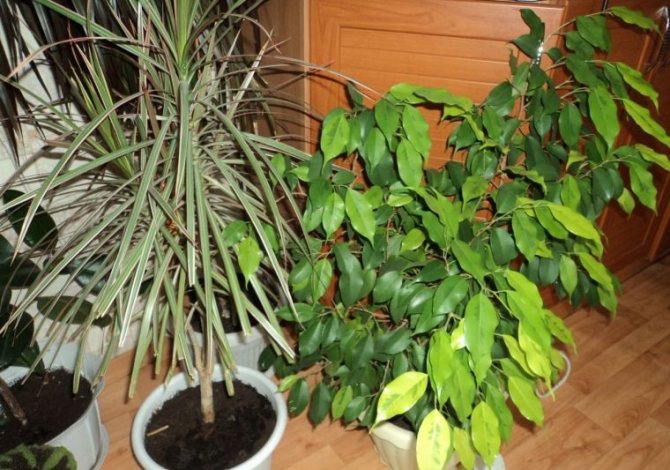

Watering and humidity
In summer, watering the plant should be moderate, depending on the drying out of the surface of the earthen coma, while maintaining optimal moisture.
It is necessary to water the plant in several steps for uniform moisture, draining excess water from the pan that has passed through the drainage.
In the summer, Benjamin's ficus will be grateful for abundant spraying in the morning and evening, washing the leaves.
It is allowed to bathe a flower using warm, about 30-50 ° C, soft, settled water, while protecting the earth with plastic wrap.
After such a shower, before getting to its place, so as not to freeze, the flower must dry out.
In winter, watering is reduced, avoiding drying out, otherwise the plant will begin to fall out of leaves. Water is used settled, the soil is loosened before watering.
Plant feeding
For the normal growth of the ficus, the formation of a dense crown, rich color, it is worth taking care of the full feeding of the flower.
For these purposes, universal flower fertilizers are used, applying them from spring to late autumn, alternating with organic and mineral varieties.
Concentrated dressings are applied while watering the plant. The dosage is calculated based on the growth rate, the faster the ficus grows, the more often it is necessary to feed.
Features and secrets of care:
Ficus Benjamin - home care, photo of the plant
Each of us met such an unpretentious plant as ficus in the homes of friends or acquaintances, public places or official institutions. The most common in our country is Benjamin's ficus, which is distinguished by its unusual white-green leaves. Caring for this plant will seem a simple task for both a novice florist and an experienced one. It is worth considering its features in care, watering and reproduction, so that the plant pleases the eye with its blooming appearance.
Plant features
This plant is a guest from warm southern latitudes; in the wild, our houseplant grows freely on the streets of the Philippines, China, India, Australia. But both indoor and outdoor ficuses of this variety look the same - like a tree with a smooth silvery-white bark. The plant has a branched crown and aerial roots - a heritage of tropical forests.
At home, ficuses grow gigantic in size - up to 20-30 meters in height, smaller specimens live in our apartments. A distinctive feature of this variety are pointed large leaves, which often have a beautiful motley color.
By the way, many tourists are surprised that ficuses growing in a free environment not only grow to the skies, but also bear fruit! In fact, the bright red fruits growing on the branches of wild-growing ficuses are not berries, but flowers. At home, the plant rarely blooms, it is much more likely to see an unusual phenomenon in ficuses growing in greenhouses.
Popular varieties
The variety of ficus Benjamin also becomes a discovery for novice gardeners. The varieties of this small tree differ in both the structure of the roots and the color of the leaves. There are even some species that are successfully planted in open ground - the formation of Benjamin's ficus does not bring any particular difficulties. We invite you to admire the photos of the most famous options:
- The completely dark green leaves are found in a plant called exotic - they are slightly wavy and can grow up to 6 centimeters in length. In appearance, it can be easily confused with a plant of the Danielle species, which also has large dark green leaves.
- The Monique variety cannot be confused with anything - this shrub has long wavy leaves of a light green hue. If you want an unusual color, then you can purchase Golden Monique, whose color resembles golden (in fact, they are light green with small inclusions of dark green). These species can be called relatively moody.If you want to grow a tree with a beautiful color, like that of Golden Monique, but without corrugated leaves, then you should get Reginald.
- There are varieties with a beautiful white border around the edges of small leaves, such as Kinkye. This shrub will have to pay a lot of attention, regularly forming a beautiful crown. Nikole has even more white on the leaves.
- Sophisticated gardeners adore the Starlight ficus, which looks very unusual in any area - green leaves are almost invisible on its white leaves.
- A very unusual Buklee ficus with bizarrely curved leaves is often grown at home. If you like this option, you can get Barok with small and tightly curled sheets.
- Summing up, we suggest that you admire such an unusual variety of Benjamin ficus as Kurly - hell for perfectionists. The plant can have both completely green and almost white leaves, both slightly and overly curved leaves can grow at the same time. Such a tree looks very unusual and will be remembered for a long time!
Benjamin's unpretentious ficus - how to care?
A beautiful plant really does not require any special care. Here are the basic rules that must be followed in order to grow a beautiful green bush:
- He needs regular humidification of the air (for this purpose, spray the leaves several times a day).
- It is not recommended to keep the plant in the shade, but direct sunlight can have a detrimental effect on the growth of the ficus.
- The soil should be monitored regularly - it should be moderately moist.
- It is worth moving the pot away from an open window and drafts.
- The soil must be loosened periodically so that it does not collect in a lump.
- And, of course, do not forget about nutrient mixtures that will protect the plant from diseases.
Let's take a closer look at the rules for keeping ficus Benjamin at home, point by point.
Temperature and illumination
Since Benjamin's ficus is a non-flowering plant, it is necessary to provide it with heat, light and water all year round on a regular basis. There are no dormant periods for a tree when you can stop watering or move the pot to a cool place.
The plant feels good at temperatures from +20 to +28 degrees. With the onset of cold weather, it is quite difficult to maintain such a temperature in the room, it can drop by 5–7 thermometer divisions, and this will be enough for its comfortable development. But if the room is less than +14 for a long time, then the green pet may begin to lose leaves.
Florists have long noticed that ficuses with light spots on the leaves are more capricious and demanding than their completely green counterparts. For example, a variety with green leaves can be placed on the north window and it will develop quite tolerably, only a little slower than usual. But for spotted varieties, you will have to think over a system of additional lighting during a period when there is a lack of sunlight outside.
Humidity and watering
As already mentioned, this tree loves regular spraying, especially in an arid home microclimate with heating batteries turned on. We recommend spraying the plant with chilled boiled water. In winter, the Benjamin ficus pot must be removed away from radiators and an open can of water or a mechanical air humidifier should be placed in front of it.
Watering should also be regular. On hot days, the soil is carefully monitored, not allowing it to dry out, it should always be slightly moist. Overflowing is also not recommended, so the excess water must be drained from the pallet. During the winter months, watering becomes less abundant as the temperature drops and the tree does not need as much moisture.
Regular watering of the Benjamin ficus should coincide with the periodic procedure for wiping the leaves from dirt and dust.
Fertilizers and substrate
In order for the ficus to develop well, reproduce actively and give a lush and beautiful crown, it is necessary to choose the right soil in which it will grow. We recommend that you choose store land specially selected for this type of plant for these purposes.
To take root and take root well, the tree will need loose earth. In the future, during transplanting, you can create a denser soil.
Top dressing may be irregular, but additional minerals should be added to the soil along with watering. In the spring-summer period, fertilizer can be applied once every two weeks, choosing a composition suitable for ficuses or deciduous plants. In winter, it is not recommended to apply top dressing, however, if the plant develops well, then you can give a vitamin mixture in a low concentration.
In the warm season, fertilizers should contain more nitrogen in order for the tree to actively develop and grow. With the arrival of autumn, nitrogen fertilizers fade into the background to create a dormant period.
The fertilizer is dissolved in water for irrigation or a concentrated solution is added after watering to prevent root burns.
When and how to prune Benjamin's ficus?
If the ficus is actively growing, for example, in outdoor conditions, then it must be regularly trimmed, pinched and formed a beautiful crown. It is recommended to do this in the warm season, when the plant can quickly recover. In winter or autumn, Benjamin's ficus actively consumes nutrients accumulated in the trunk and branches, you should not cut them off.
The procedure must be performed with a sterile instrument, cutting at a slight angle to the upper edge. In the process of crown formation, it is important to preserve the natural appearance of the plant.
If you want to see a small bush of a classic shape, then it is enough to periodically trim the branches by 10-15 centimeters at the main trunk and by 5-10 cm - the side branches. In order for the formation of branches and leaves to occur evenly, it is recommended to rotate the pot with the plant relative to the sun.
If the pruning has not been done for a long time, then the tree may grow an overly dense crown. It can be thinned out by cutting off the branches growing deep into the ficus.
Many are interested in the process of creating a tree with an unusual wicker base - in the form of a braid or plait. Such a tree must be formed from a young age, when the main trunk is still quite flexible. Several cuttings are intertwined in the desired form and such a bush is planted in the soil. It is worth making sure that the weaving is relatively free - and the trees could not disperse, and there is a place for the thickening of the trunk. Such weaving often looks beautiful and unusual, but there are also cases when one bush begins to lag behind in development or, conversely, grows too quickly, and then the whole weaving loses its charm.
Ficus Benjamin - reproduction
Usually, reproduction begins in the spring, when the sun wakes up and there is an opportunity for a young plant to get maximum light for active growth.
- Cuttings. To get a young tree, a stalk is carefully cut from an adult ficus with a sharp blade. He should be quite young, but not yet numb. It is desirable that 3-5 leaves grow on a branch. The milky juice that is released when cutting the cutting is harmful to health, so it is thoroughly washed off. The sprout can be germinated both in the ground and in the water - the second option is preferable. Having transplanted the shoot into water, two weeks later, at its end, you can see a white bloom - a harbinger of fresh roots. If you want to grow a new plant right in a pot, then you should carefully choose a substrate - a mixture of sand and peat. In any case, during the first weeks, the scion will need to be covered with plastic wrap and placed in a warm place.
- Rooting of layers. An annular incision is made on the stiff trunk, removing the bark.Sphagnum is placed on the bare trunk and covered with plastic wrap on top. It is carefully fixed with wire, being careful not to damage the ficus. As soon as the roots become visible under the film, the twig can be cut and transplanted into the substrate.
- Seeds. This breeding method is also possible for ficuses. After soaking the seeds for a day, the water is periodically changed. Then the swollen seeds are transferred to a small container on a prepared substrate consisting of peat and sand. Covering it tightly with polyethylene instead of a lid, the container is moved to a warm place, preferably even on a battery, so that the soil is well warmed up to a temperature of + 20–25. Seed germination is good; in a month, with proper care, the first shoots will appear. Well-moistened, but not wet, soil is necessary for their development.
Ficus Benjamin diseases
What problems can occur on the beautiful branches and leaves of this decorative tree?
- Anthracnose - the leaves constantly dry up, large brown spots appear on them.
- Botrytis - due to an excess of liquid, a white bloom appears on the leaves.
- Cercosporosis - ugly round dark spots appear on the edges of the leaf, the foliage gradually turns yellow and dies off.
Almost all diseases of this plant are associated with improper care. If signs of disease are detected, the affected parts are carefully cut off, restoring the necessary care.
In addition to diseases, the plant is susceptible to attacks by pests - these are spider mites, aphids, scale insects and mealybugs. You can save ficus from their presence either with purchased insecticides or garlic tincture. Experienced housewives successfully clean the plant with a solution of ordinary laundry soap, but you should be careful with it.
Ficus Benjamin
domsad.
Ficus benjamina (ficus benjamina) at home
Family: Moraceae.
Homeland: India, Southeast Asia, northern Australia.
In indoor culture, it is grown as an ornamental deciduous plant.
Features of the content of ficus
When purchasing Benjamin's ficus, most of us are soon faced with the fact that a significant part of the leaves fall off.
The main feature of Benjamin's ficus content is that he does not like change. With any changes in the conditions of detention, partial leaf fall occurs. First of all, one must understand that leaf fall is a natural reaction of the ficus, developed in the process of plant evolution. The native natural conditions of ficus are divided into two periods: the rainy season and the dry season.
In natural conditions, foliage falls off in anticipation of the dry season to reduce water evaporation. The roots reduce the supply of water to the crown, and the fall of the foliage balances the level of evaporation and the reduced amount of water that the roots supply to the crown of the plant.
When growing ficus in room culture, this feature is also true - when conditions change, the plant experiences stress and sheds foliage. After the stress passes, the plant builds it up. The maximum amount of foliage will have a plant that is grown for a long time under constant conditions close to optimal.
Under the right conditions, in the middle of autumn, many varieties of Benjamin ficus shed some of the foliage - this is a natural process. In the spring and summer, the autumn loss will be compensated by the growth of new leaves.
If the shedding of leaves occurred in a different period, and after 2-3 weeks the development of new foliage began, then the plant coped with the stress.
Lighting
Optimal lighting:
- in the period from April to September from 11-00 to 17-00 - diffused sunlight; before 11-00 and after 17-00 - direct sunlight;
- in the period from October to March - direct sunlight.
The optimal duration of lighting per day is 10 hours. To form a uniform bush shape, the plant is rotated 90 ° around its axis every week.
When growing ficus with optimal lighting, the plant will have a dense, lush crown. In insufficient light, the branches of the plant will be weak, the crown is sparse.
Content temperature
Optimum temperature for development:
It is desirable that there is a day / night temperature difference of (5-6) ° C. The admissible minimum short-term temperature is 10 ° С. At temperatures below + 16 ° C, and above + 35 ° C, Benjamin's ficus falls into a state of stagnation - its vegetative development stops.
Humidity. The optimum air humidity is above 50%.
Watering. The optimal frequency of watering is with light drying of the earthy coma between waterings. Ficus Benjamin refers to plants that are sensitive to chemicals found in tap water. Therefore, when using tap water for irrigation, it must be defended for a day. The settling will reduce the chlorine content in the water.
The soil. The optimum acidity of the soil mixture is pH 6.0 to 6.5. The composition of the soil mixture: 3 parts of sod land + 1 part of peat + 1 part of coarse sand (or perlite).
Ficus benjamin transplant
It is recommended to replant mature plants once every two years. This is due, first of all, to the fact that the substrate is destroyed, losing its structure, as a result, its drainage properties deteriorate. For ficus benjamin, it is important that the potting mix has good drainage properties.
If necessary, the transplant is carried out in mid - late spring, after active growth resumes.
When transplanting, all the roots are cut off, which begin to grow upward after they have rested against the bottom of the pot - the procedure is carried out once every five years. Broken and rotten roots are also cut. When pruning roots, there is a rule - no more than 1/3 of the roots are removed.
When transplanting ficus benjamin into a larger container, the new one should be a maximum of 15% larger than the previous one. When choosing a pot, keep in mind that the larger the plant, the greater the overturning moment and therefore a heavy pot is needed for greater stability.
Fertilizer
Fertilizers with a content of N-P-K = 10-10-10 are used as top dressing. Top dressing is carried out during the growing season from April to September. But there are exceptions: prolonged cloudy days, high temperature (above + 35 ° C) - during these periods we do not feed.
Top dressing is also not carried out:
- during the period from November to February;
- at a temperature of content below 20 ° C;
- during the period of leaf fall.
If, during feeding, the solution gets on the leaves, it must be washed off with water, otherwise chemical burns cannot be avoided, since the leaves of the ficus are sensitive to the effects of chemicals.
Feeding frequency:
- if the conditions of detention are close to the recommended - once every two weeks;
- if the conditions of detention differ greatly from the recommended ones - once a month.
For top dressing, complex mineral fertilizers are used for decorative deciduous plants, at a concentration of 50% of the recommended one.
Ficus benjamin - propagation by seeds and cuttings
1) Reproduction by sowing seeds.
Consider the option when the benjamin ficus seeds are purchased from a store. They have a high germination capacity, which lasts for a long time, if: the conditions of storage and transportation are correct, the seeds are ripe. No additional seed treatment is required before sowing. Seeds are planted to a depth of 5mm.
The composition of the soil mixture: 1 part of sod land + 1 part of leaf humus + 1 part of perlite + 10 g of bone meal (for every 10 liters of the mixture).
Conditions required for germination:
- germination period - up to three months.
- the optimum temperature is 20-25 ° C.
- the potting mix should be moist throughout the germination period, but not wet.
After the seedlings develop a few leaves, they are planted in individual pots.
2) Reproduction by rooting stem cuttings.
The optimal cutting length is about 15cm. Cuttings are cut with a sharp knife; the fabric should not wrinkle at the cut. White juice emerging from the slices is washed off with warm (30-40 ° C) water. Rooting is best done in transparent disposable cups (200 ml). The lower leaves of the cutting are removed, the rest should not come into contact with water. In the process of rooting, partial fall of the cutting leaves is possible - not scary.
Rooting conditions for the cuttings:
- purified water is required;
- lighting: diffused light / partial shade;
- rooting period: 2-3 weeks.
After the roots have developed more than 3 cm in length, the cutting is transplanted into the soil mixture as for sowing seeds. A month after planting, we begin to feed.
Cuttings with variegated leaves take longer to root than cuttings with green leaves.
- Ficus is lyre-shaped. Ficus Lyrata.
- Benjamin's ficus - falling leaves, diseases, etc.
The value of ficus Benjamin in the house
Different peoples have different attitudes towards ficus. Representatives of eastern countries believe in its magical ability to help owners in all moments of life. And the Slavic peoples, on the contrary, are afraid of this tree, they are sure that it brings misfortune.
For Thais, it is a sacred tree that drives away the dark forces from the house. It is the symbol of the country's capital, Bangkok. Residents of Thailand are sure that the ficus gives them happiness and joy. This is probably why they are the most smiling people.
The Chinese are confident that Benjamin's ficus will fill the home with a clean, wholesome and positive aura. Therefore, they always give it to the newlyweds. A tree can live in a family for tens of years, being inherited. All this time, the plant will drive out evil spirits from the house and remove the negative. It brings vitality, vigor, health to its owners.


The Slavs believe that this seemingly attractive tree brings discord, quarrels, scandals to families, which further leads to a break in relations.
Rooting methods
When multiplying ficus Benjamin in at home
cuttings are rooted in water or in prepared soil. If the air temperature is maintained at 20-22 ° C and the required air humidity is maintained, the shoot will give roots within a month. Of course, they make sure that pests do not attack young shoots, and the roots do not rot. With proper care and compliance with sanitary standards, rooting will be successful in both ways. To stimulate cell division and root formation, the bottom of the cuttings is treated with Kornevin. A few drops of this or an analogue preparation can simply be dissolved in a liquid.
In water
Reproduction of ficus Benjamin
by rooting the shoots in water, they are carried out in a container with a removable bottom. The transplant process will be greatly facilitated. For the successful formation of the root system, water is poured so that it does not affect the lower leaves of the shoot, otherwise their plate will begin to rot. To prevent trunk rot, coal powder is dissolved in water. The conditions for growth are the same as for an adult plant. The fluid is changed periodically. When the ficus stalk gives roots, the seedlings are planted in the ground at a permanent place of "residence".
In the ground
Longer method in time. Sections of processed and dried twigs are sprinkled with charcoal powder. Then they are lowered by one kidney into the prepared and disinfected soil. Once the seedling is planted, the soil should be watered with warm water and slightly compacted. For successful rooting, young ficus benjamin
placed in an impromptu greenhouse.
It is created from cling film or a bag in which a hole is made. The polyethylene should cover the pot of soil, leaving the shoot outside. As for the previous method of rooting, the flowerpot is placed in a warm, bright place, avoiding direct drafts and maintaining a moderate soil moisture. Make sure that it is not spilled. Periodically, the cellophane is removed to ventilate the substrate.This will prevent root decay. When young growth forms foliage, reproduction of ficus benjamin
went well.
Where is the best place to put the ficus
In order for the plant to give the maximum of its wonderful properties, it is necessary to choose the right place for it.
- Feng Shui allocates the southeast part of the room for him. From there he will send fluids of calmness, right thoughts, decisions.
- In the living room, with its help, they establish relations between family members, friends, guests. Unwanted people won't come in here.
- In the kitchen, a pot with a tree will provide the family with the necessary financial flow and the refrigerator will always be full.
- A good place for a plant is a bedroom. Sleep under its influence will be calm, without terrible dreams.
- In the office, the ficus helps to avoid conflicts, adjusts to fruitful work.
Ficus in the house during pregnancy
Ficus benjamin is the protector and guardian of the house. It also helps to harmonize your family relationships and helps you get pregnant. To do this, you just need to follow some rules.
To make your man feel better in bed, put him next to the bed. This will energize your energy and help you get pregnant.
The fig tree (a burning bush in the Bible) according to Christian teaching is a plant that was chosen to manifest pure divine power. So this plant is also a ficus!
Also, if among your friends there are already people giving birth, then you can ask them for a twig, a shoot from their plant. This will help harmonize the energy in your home.
Where is the best place to put the ficus
A large number of people are worried about the question - where is it better to put the ficus? The very ancient practice of Feng Shui will help to answer it:
- East side
- South side
- Closer to the light
If you put it in one of these places, then the energy of the plant will be able to open up to its full potential - it will bring peace, peace, harmony to your home and relationships.
Also, for a ficus plant, it is worth choosing a specific room according to your preferences:
Ficus benjamin in the kitchen... It is installed to attract wealth, to establish the monetary sphere. If your goal is to start making money in the near future, then this place is best suited.
Ficus in the bedroom... Helps to normalize sleep, relieve anxiety and nightmares. For a family bed, this is also a great opportunity to get pregnant sooner. To do this, a pot with a plant should be placed near the head or behind it.
Ficus in the living room... The sign says that placed in the common room, it thereby will help to attract the right people into your life. And those who secretly treat you badly, but nevertheless come, will begin to feel uncomfortable and will soon leave your life.
Ficus in the office... This is the most favorable place for creating a pleasant and at the same time working mood. With it, it will be easier for you to delve into any problem, focus on the task at hand.
How to grow ficus?
Ficus is one of the most popular indoor plants and has long won the sympathy of indoor plant lovers, thanks to its decorative qualities and unpretentious care. They are ideal for decorating any interior. Ficuses look great in group plantings and with other plants. They can be seen in holiday homes, offices, winter gardens and, of course, in apartments and private houses.
Growing ficus
Consider how to grow a ficus. It is necessary to propagate the ficus in the spring, since before the fall the young plant should get stronger, adapt and take root. There are several ways to reproduce ficuses.
- Cuttings. Apical cuttings are used, which must be cut at an angle of about 10-20 cm in length. It is better to use a knife when cutting, since scissors can damage the tissue, as a result, the rooting process slows down. The lower leaves must be removed, and the upper ones are recommended to be rolled into a tube in order to reduce evaporation.The cut must be dried a little, the cuttings should be rooted in water.
- Seeds. Many are interested in how to grow ficus from seeds. The fact is that it is impossible to get ficus seeds at home. For their pollination, pollinating insects are needed, which are not at home. Therefore, the seeds can be purchased at the store. Before planting, they are treated with a growth stimulant. They require a moist, lightweight, breathable substrate. Therefore, it is necessary to add sand to the base, which mainly consists of leafy earth and peat. It is necessary to plant seeds to a depth of 0.5 cm, and the distance between them should be about 1.5 cm. The substrate is well moistened and covered with a film. Every day, the film must be removed for 15 minutes to avoid excessive moisture. They require bright lighting, but direct sunlight is not allowed. Germination temperature should be 23-25 degrees.
- Air layering. In this way, large tree-like ficuses are propagated. It is necessary to select a trunk, remove leaves and shoots from it. Two transverse annular cuts are made and one longitudinal cuts are made between them. Lubricate the incision sites with a stimulant and wrap it with wet sphagnum and put polyethylene on top of it. Moss periodically requires moisture. After the formation and development of the roots, the cuttings are planted separately.
Ficus Benjamin
This is one of the popular houseplants. It has uneven bark and beautiful small glossy leaves. Its height can reach three meters. Consider how to grow Benjamin's ficus. Reproduction of this type of ficus occurs by cuttings into water or ground. It is recommended to hold a freshly cut branch under running water for several minutes. This must be done so that the juice that stands out on the cut does not interfere with it from taking root. After planting, the container with ficus is placed in a warm place with high humidity. Ficus is fed twice a week, it should be watered with warm water, but in no case should it be poured. This plant loves a warm shower, which can be done once every three weeks.
Ficus bonsai
Bonsai can be grown from common Ficus and Benjamin Ficus. In order to know how to grow ficus bonsai, you need to follow these guidelines:
- Cut off several cuttings from it, about 15 cm long and put them in water.
- When root buds appear, the sprouts should be planted in the ground.
- Pick up a flat pot and plant the sprouts next to each other in it. In this case, the most common soil is used.
- Weave twigs as they grow.
- After strengthening the root system, the upper protruding parts should be exposed. You can put a beautiful stone under the root, the root can twine around it, it will look very beautiful.
- The first weave of twigs can be secured with wire, and removed after a few weeks. If scars appear, this is not scary, they will disappear over time.
- Branches that grow strongly must be cut off. And over time, the tree will form into a bonsai.
Why can't you keep
For the Slavs, keeping a ficus at home means incurring the envy and anger of people. In the family, discord gradually begins, constant conflicts ruin the once harmonious relationship.
Girls who have this cute tree in their room can be forever alone. The flower seems to drive away the grooms from the beloved mistress. He doesn't want to share it with anyone. Only a guy appears, but after a while he finds himself another.
Men with ficus on the window change before our eyes. Their character becomes quarrelsome, grumpy. The woman herself is already beginning to think about parting with him. This is the point of view of the Slavs. Other inhabitants of the planet see only positive aspects in the plant.
Where you shouldn't put it
The center of the room and the northeast are considered not a suitable zone for ficus according to Feng Shui. In these places, its beneficial effect is minimal.It is not recommended to put it in the nursery. Since the child's body is not yet strong and how it will react to such a neighborhood is unknown.
You cannot hide the pot in the shade. It is difficult for him to grow on the northern window, his strength is spent on maintaining his own growth, and not for the benefit of a person. The tree is quite whimsical to care for. No need to take him out to the balcony, he does not tolerate drafts. The window sill should also not be blown out of the cracks. Ficus loves light, but not direct burning rays of the sun, but muffled ones. It should be diffused light.
Planting a shoot in the ground
You can plant the process in the ground immediately after processing the cut. What kind of pot is needed for a ficus depends on its type, size and shape. For indoor species, a medium-sized pot is suitable. For large, tree-like species, take large containers, tubs. To prevent the plant from rotting, drainage is placed in the ficus pot: expanded clay, pebbles, shards. The drainage is covered with moss. This way, excess water will drain into the sump and the drainage will not be clogged with earth. A loose mixture is used as a soil: peat, vermiculite, perlite, sand. The stalk is planted, deepening the lower node, and watered abundantly. A peg can be placed to support the appendix.


Ficus can be propagated with a leaf, although this is more difficult than cuttings.
Next, the pot is placed in a warm, damp place. Avoid direct sunlight. It is good to maintain constant conditions by using a mini greenhouse. You can take a glass jar, plastic cup, plastic bag. The mini-greenhouse is periodically ventilated. Control that the ground is moist, but not too much.
After 3 weeks, the first leaf appears, the growth of the cutting begins. This means that it has taken root. The mini-greenhouse is opened more often so that the young ficus gradually gets used to the conditions of the room.
Growing problems
Among indoor plants, Benjamin's plant has an average degree of difficulty in growing, so you need to pay attention to its whims.
Most often, novice florists have such problems when growing Benjamin's ficus:
- Dry leaf tips in winter, it signals about insufficient air humidity, which is most often associated with the inclusion of heating. In this case, it is required to increase the frequency of spraying, organize artificial lighting to increase daylight hours. This will help the plant to wait for spring calmly and without loss.
- The plant sheds leaves, the so-called sudden leaf fall should alert the owner of the ficus. Thus, the flower reacts to abrupt changes in the conditions of detention, for example, a decrease in temperature, the appearance of drafts, a change of place. Also, such a reaction can occur with abundant watering in the winter, when it would be worthwhile to reduce the amount of moisture, but this did not happen.
- The change of seasons in any deciduous plant causes yellowing and shedding of leaves... Ficus in this case is no exception. However, if this happens at a different time not associated with the natural onset of autumn, it is necessary to sound the alarm - there are mistakes in leaving. There are two main reasons due to which the leaves of the ficus fall: an excess of water, which can destroy the plant, and too low a temperature.
- If the plant stands still for a long time, does not grow or develop, it is worth assessing whether the size of the pot is correct. The roots begin to wither, stop developing and die if the pot is too large in relation to the size of the plant, on the contrary, too tight a container prevents the development and formation of the crown.
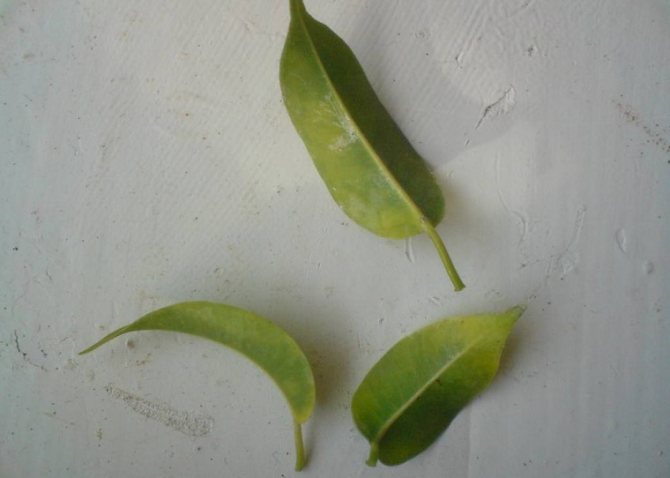

Ficus sheds leaves for a reason
If correcting mistakes in the care and maintenance of a flower does not lead to improvements and the desired result, you should pay attention to the presence of diseases and pests.
Popular varieties with photos and names
There are several varieties of Benjamin ficus, each of which has its own special appearance.
Exotic variety
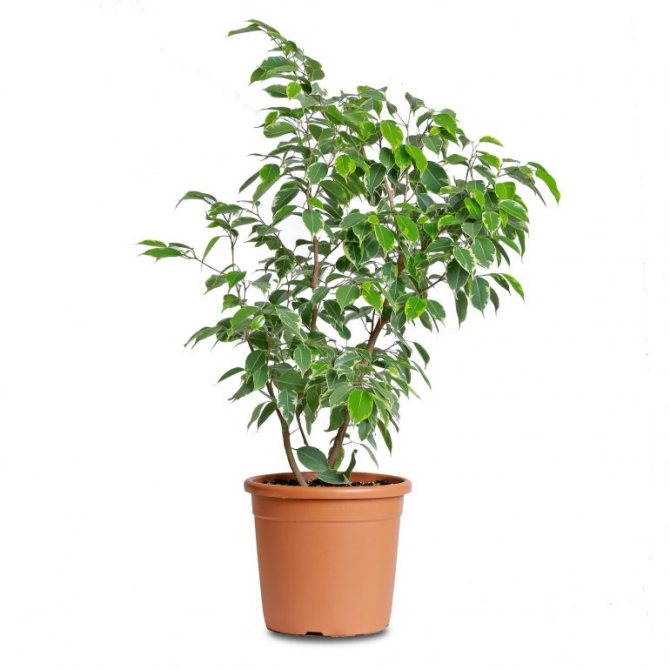

It is a compact and unpretentious plant with dark green leaves with wavy edges. It is recommended to start acquaintance with Benjamin's ficus with this particular variety due to its unpretentiousness.
Variety Daniel (Danielle)
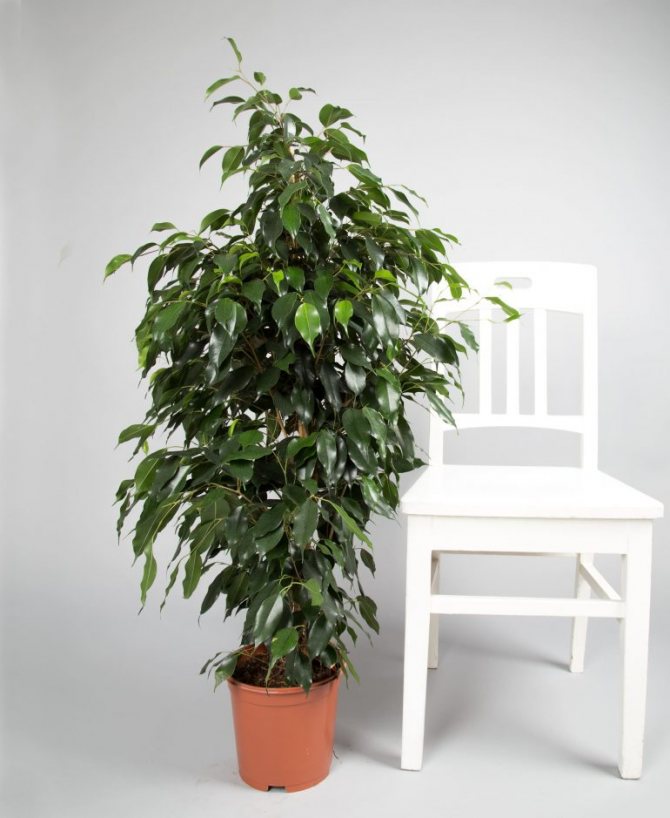

Very similar to the exotic variety. Its leaves are rather large (6 cm) and dark green.
Monique variety
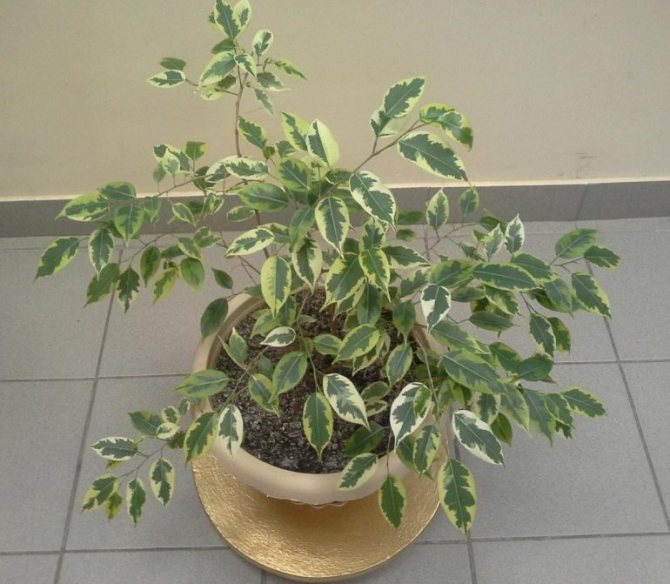

A very common variety, which is divided into two similar types: simply Monique and Golden Monique, whose leaves are characterized by a golden hue. This variety is more capricious than Daniel and Exotic.
Reginald variety
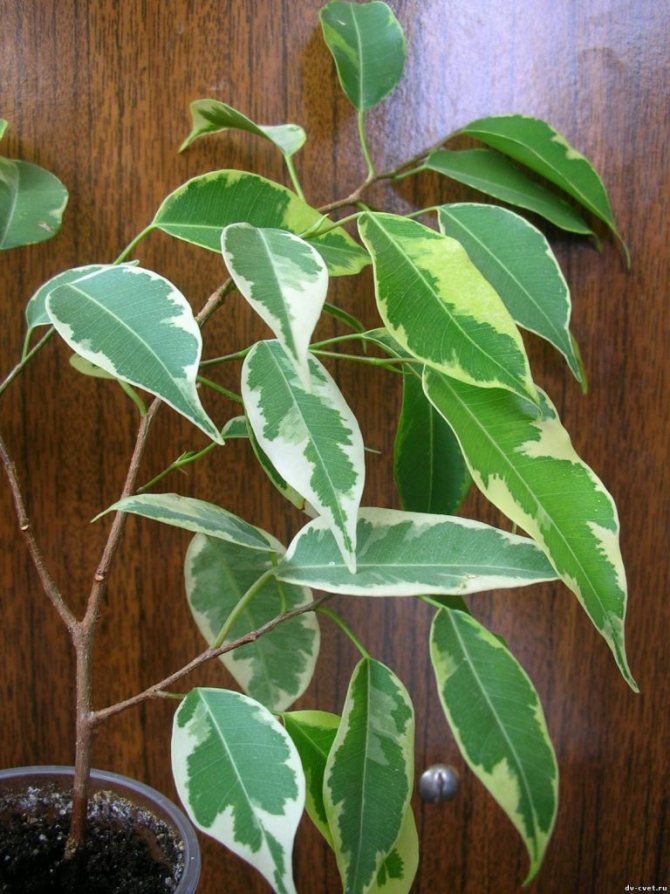

It is the most popular variety and is highly regarded for its variegated leaf color. Small light green spots are scattered chaotically on a light green background. The edges of the leaves are even, not wavy.
Kinkye variety
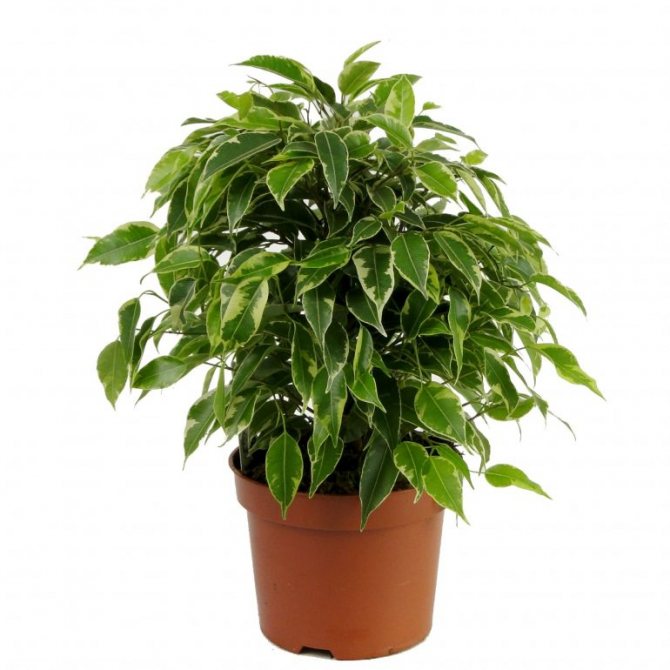

The color of the leaves is characterized by a combination of a dark green background and a light green edging. The leaves are rather small, not exceeding 5 cm. It is this variety that often needs pruning and shaping. You can create a fancy shape out of it.
Variety Nicole (Nikole)


The winner for the uniqueness of the pattern. The light green edging here is much wider than Kinki's. This contrast of light and dark looks attractive.
Starlight variety
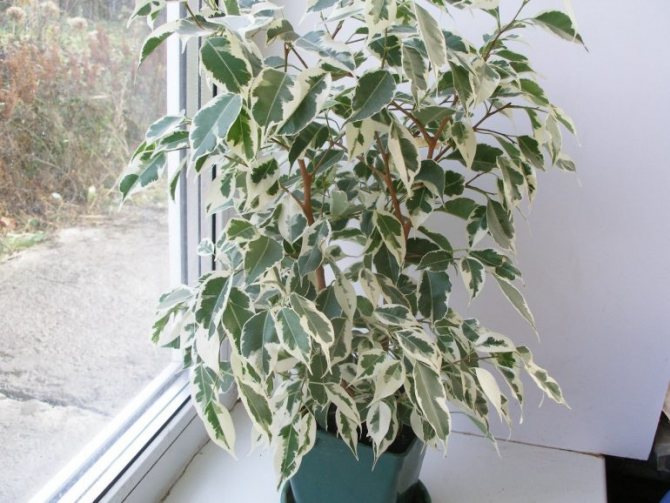

The leaves of this plant are almost completely white, it looks very impressive. Due to the lack of chlorophyll, the plant needs intense lighting.
Barok variety
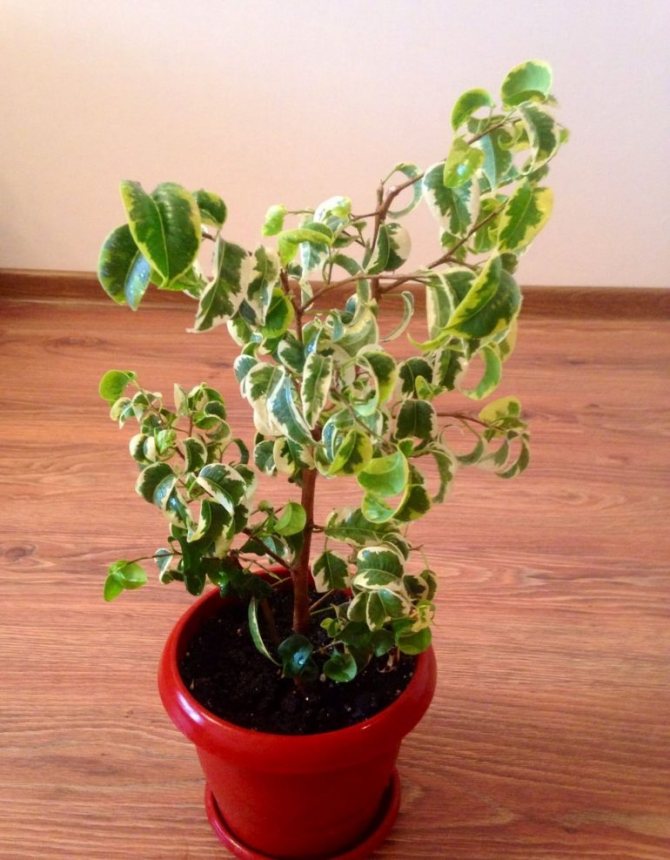

Its small leaves curl amusingly, which gives the plant a very unusual look.
Caring for a new plant
After the new plant is received, it is necessary to plant it correctly in a separate pot. Young ficuses are very delicate and must be handled with care. A drainage layer is poured into the pot, it can be ordinary expanded clay. The nutrient soil can be additionally disinfected and calcined in the oven. The temperature is set at about 200 degrees and the substrate is kept at this temperature for about 30 minutes. The substrate is cooled and used for its intended purpose.
The soil is poured into a container, compacted a little. A deepening is made in the soil, the roots and part of the stem of the new ficus are carefully placed in it. The deepening is covered with earth and watered. After planting the seedling, it is not recommended to strongly compact the soil, you can damage the delicate roots. You can compact the soil with watering.
Young sprouts should not be placed in drafts, in rooms with low temperatures or fluctuations. It is important to water the seedlings with warm water only. The water temperature must be at least 25 degrees.
Knowing the rules and secrets of breeding Benjamin's home ficus from one plant, you can get many new ones. Adequate temperature, nutrient medium and humidity are important conditions for proper reproduction.
fikus.
In your own apartment, you can create amazingly beautiful corners of wildlife that will delight the eye, attract attention and benefit physical and psychological health. So, bonsai will be an excellent option even for a small apartment. This is a composition of a small tree, the traditions of which came to us from China and have successfully taken root not only in Russia, but in many countries of the world. Some growers advise using a blunt ficus to create it, the cultivation from the seeds of which will be discussed in a little more detail.
Blunted ficus is an excellent plant option for creating bonsai. It belongs to evergreen plants and has interesting aerial support roots. Growing it from seeds is not easy, but possible.
Growing ficus for bonsai
In order to grow ficus from seeds, readers of Popular About Health will have to try. Such plants need good lighting, so it is advisable to take care of the possibility of organizing backlighting in advance. It is best to use fresh seeds for planting, as they are characterized by maximum germination.But at the same time, the most favorable period for sowing is considered the time from mid-February to April. Sowing seeds is allowed until July. If you purchased seeds in a store, it will not be superfluous to soak them in a growth stimulator (a solution of such a substance) a day before planting. A good choice would be Heteroacusin, Epin or Humate solutions. They will increase the germination of the planting material and add resistance to diseases in the future.
Blunted ficus seeds are extremely small in size. Therefore, for a successful sowing, it will not be superfluous to prepare a thin stick and a magnifying glass.
Ficuses grow best on light soils, which are distinguished by air and water permeability. The soil mixture can be prepared independently from leafy soil and peat. To this mixture you need to add some sand and a little fertile garden soil. You can also purchase suitable soil from a flower shop.
For planting seeds, it is worth using fairly wide containers - this will facilitate the care of the seedlings. But they should not be deep, as the seedlings will have to be replanted soon. Even if you only want one tree, it is worth sowing a few seeds. After all, their germination may be far from one hundred percent. And in order to get the most healthy and beautiful plant, it will not be superfluous to reject the obtained seedlings.
Landing
Pour the soil for planting ficuses into the planting containers not to the edge, but three to five centimeters below the side. Then moisten it with a spray bottle and tamp it a little using a suitable board or just your palm.
Spread the seeds evenly over the soil surface (either scattered or in rows). To do this, you can dip the tip of a thin stick in water, "glue" one seed to it and transfer it to the ground.
After landing
After that, you need to sprinkle the seeds a little on top of the ground - but in a thin layer, no more than three to five millimeters. Moisten the soil well using a spray bottle.
After finishing planting, cover the container with crops with polyethylene or glass. This will create suitable greenhouse conditions for the seeds to germinate. The shelter must be removed daily for ten to fifteen minutes, eliminating excess condensation and preventing waterlogging. In this case, it is necessary to carefully assess the condition of the soil, and carry out its further moistening if it has dried out.
After the first shoots appear, you can remove polyethylene or glass for one to two hours a day. And when almost all the seeds germinate, the shelter should be removed completely.
Seedlings need to be provided with sufficiently bright lighting throughout the day, but at the same time it is necessary to protect them from direct sunlight. With a short daylight hours or cloudy weather, additional illumination of seedlings should be carried out using fluorescent lamps. The optimal temperature for growing such seedlings is twenty-three to twenty-five degrees. Watering the seedlings is carried out systematically, keeping the soil constantly moist, but not damp.
After the first leaf appears on the seedlings, you need to pick them into separate containers. This is an excellent time to thin out seedlings to eliminate the weakest plants. Ficus does not always grow healthy from seeds ...
Before transplanting, the soil near the seedlings must be thoroughly moistened. Small plants are carefully removed from the planting container together with a clod of earth. And in new pots, it is imperative to organize a good drainage layer, for this you can use pebbles, perlite, expanded clay, etc. Drainage will help to avoid moisture stagnation. The soil mixture is used the same as for growing seedlings.
The growing seedlings need a little care. They need to be watered well and periodically sprayed with a spray bottle to maintain adequate moisture levels.Good lighting is also extremely important.
The formation of a bonsai from a growing ficus is carried out only after the plant has formed a rather thick trunk. It will need to be chopped off, leaving a stump, roots cut and grown as recommended.
Blunted ficus is ideal for bonsai, especially for beginner growers.
Briefly:
Seed collection October 2019. Suitable for creating bonsai.
Description
Ficus BENJAMINA or Ficus Benjamina is an evergreen shrub and tree, one of the most common indoor plants, among ficuses it is the most popular species. Belongs to the Mulberry family.
In the wild, it grows up to 25 m in height. Distributed in India, China, Southeast Asia, the Philippines, and northern Australia.
Ficus Benjamin is a wonderful decoration for almost any room: an apartment, a large hall, an office, hallways, a winter garden, it fits into absolutely any interior style. In areas with a tropical climate, Ficus Benjamin is actively used for landscaping, creating garden sculptural forms and sheared hedges.
Leaves are glossy, smooth, thin-skinned, oblong-oval with a pointed apex, 6-13 cm long and 2-6 cm wide. The arrangement of the leaves on the branches is alternate, the leaves are formed in one plane. The edge of the sheet is full-edged. The venation is reticulate, the central vein is poorly expressed, with 8-12 pairs of lateral veins. The petiole is about 2 cm. The bark is gray with sparse brown streaks. The crown is wide, the branches drooping. Fruits - syconia - round or oblong, paired, up to 2 cm in diameter, red or orange, inedible.
At home, Ficus Benjamin can be quite large - to the entire height of the room, by trimming its crown can be formed as needed. A white milky juice stands out on the cut.
Young shoots of this type of ficus are very flexible. Often several cuttings are planted in one pot; as they grow, the stems are intertwined into a pigtail. The touching stems grow together over time and form beautiful growths.
If you provide this ficus with favorable conditions for growth and learn to "understand" its needs, then Benjamina Ficus will live in the house for many years and become more and more beautiful and exotic.
Ficus Benjamin. Care and maintenance:
Lighting:
Ficus prefers bright diffused light; plants should be shaded from direct sunlight in summer. Suitable for growing near western and eastern windows. At windows in the south direction, plants should be shaded from the direct midday sun. Can grow near northern windows. In winter, the plant is placed in a bright place. Ficus feels good in bright artificial light. In the summer, you can expose the plants to the open air, in a place protected from midday sunlight. Plants should be accustomed to the new level of illumination gradually. Ficus does not like changes, so it is better to immediately determine a permanent place for him and, if possible, not to transfer, not to move or disturb.
Temperature:
Ficus is a thermophilic plant, so the temperature should not drop below + 12 ° C. From temperature changes, it can react with leaf fall, it tolerates cold drafts very badly.
Watering:
In the period from March to September, the ficus is watered abundantly, with soft, settled water, but allowing the upper layer of the substrate to dry out. With the onset of autumn cold weather, watering should be sharply reduced, since the plant enters a period of forced winter dormancy. Excessive watering at this time leads to the shedding of leaves, and sometimes to the death of the entire plant.
Humidity:
In both summer and winter, ficuses need frequent spraying with soft, settled water at room temperature. It responds well to washing under a warm shower.
The soil:
Young ficuses should be transplanted annually into sandy humus soil.More mature plants are transplanted after 1-2 years (depending on the strength of growth), in March. In tubular specimens, the transplant can be replaced by an annual replacement of the topsoil. The soil is suitable neutral (pH 6-7). To prepare a nutrient mixture for ficus, take 2 parts of sod, deciduous land and peat and 1 part of sand or 1 part of peat, 2 parts of greenhouse soil and 0.5 parts of sand. You can add small pieces of charcoal. Or buy a specialized soil for Ficuses and / or palms. The bottom drainage layer is made of broken brick or expanded clay.
Top dressing:
Mineral and organic liquid dressings in spring and summer (2 times a month) promote rapid plant growth.
Cropping:
Pruning tolerates well, and often just needs it to maintain the shape of the crown. It is held in late winter and early spring.
Reproduction:
Seeds all year round, also cuttings of Ficus easily take root in the spring and summer in humid and warm conditions (mini-plates and greenhouses). The escaping milky juice is washed off with water, after which they are planted in containers, where they are kept at a temperature of 25-30 ° C. It is allowed to root the cuttings in water, which should be changed frequently. After rooting, the cuttings are planted in 9 cm pots. The earthen mixture is made up of sod land - 1 hour, humus - 1 hour, leaf - 1 hour, sand - 1 hour.
Possible difficulties:
Sudden leaf fall in different plant species occurs for different reasons: due to waterlogging of the soil, or low winter temperatures, or lack of light, or excessive feeding, or drafts, or changing conditions of detention. If the young leaves are small, and the old ones hang down and partially turn yellow, this indicates a lack of nutrition, high temperature and dry air. Due to insufficient nutrition and weak activity of the root system, the edges of the leaves turn yellow or even fall off. Due to sunburn, insufficient air humidity, or drying out of the soil, the leaves wrinkle and dry. Excessive watering, soil acidification, root disease and lack of nutrition lead to gradual leaf fall (in addition to the natural death of the old lower leaves).
Damaged by: thrips, spider mites, scale insects.
www.adenium-
Tools
Before we cut the cuttings, we need to figure out what tools we need. Prepare everything you need in advance so as not to be distracted by anything while working.


- Knife. Remember: cut off the processes with an exceptionally sharpened knife. You do not need to tear off the ficus process with your hands or try to cut it off with scissors, so you will only harm the flower. A very important point: the knife that you will use must be disinfected before the procedure.
- A container with warm water. It is there that we place the shoots of the ficus immediately after we cut it off.
- Dark glass vessel. After all the procedures, you need to place the cutting there until it takes root.
How to accelerate root formation?
In a container with water, cuttings of Benjamin ficus stand for about three weeks, at which time the roots are formed. To speed up the reproduction of the flower, you can make shallow scratches in the place of the cutting, which will be located in the ground. Special preparations help to root the ficus well., for example, "Kornevin". Before lowering the cuttings into water, they should be soaked in a solution of this drug. When rooting in soil, the sections should be powdered with a stimulant powder.
Ficus should propagate in good soil. To obtain it, take in equal proportions:
- sand;
- peat;
- vermiculite.
It is best to disinfect the soil by heating it for 30 minutes in a steam bath. If the length of the cutting is several centimeters, it must be fixed in the pot. In this case, a peg should be threaded into the folded sheet, which is well buried in the soil.
Care after breeding
IN at home
make sure that the planted young growth receives enough water. To avoid rotting of the ground and root parts of the crop, maintain a moderate soil moisture. The soil must be warm. To do this, in the cold season, use a heating pad or heating device. Temperature fluctuations in the room should not be abrupt.
Ficus Benjamin
must adapt to the new environment gradually. Seedlings are inspected daily for pest and fungus infestation. For bonsai-type growth, several cuttings can be planted in one flowerpot, which are neatly woven in a spiral pattern.
Among its congeners, Benjamin's ficus stands out for its medium-sized graceful foliage and a spreading crown. With the advent of new varieties of the plant, its popularity is growing, and for many flower growers the question becomes urgent: "How to reproduce Benjamin's ficus?"
All ficuses are hardy and very tenacious. Their shoots, in contact with the soil, form roots and give life to new plants. Aerial roots, descending to the ground, provide additional nutrition for the growing crown. Even the unusual shape of the fruit seems to be designed so that the birds eating the flesh will gnaw and then settle the seeds.
But how to propagate Benjamin's ficus at home? Are there any peculiarities and pitfalls here? Plants of this species reproduce vegetatively without complications. The most common method is cuttings, which is how most plants are propagated. Among them are hibiscus, lemon.
Features of the
The plant is relatively unpretentious. It does not require any specific maintenance. Reproduction of ficus Benjamin can be done in three different ways. They will need cuttings, cuttings or seeds.
To propagate a tree at home, you need to choose the optimal time for this, that is, when the ficus is in a state of active growth. It's spring or summer. Due to the fact that during this period the root system is growing rapidly, the procedure will almost always be successful. It is possible to grow a full-fledged plant, even if there is only one bud on the handle.
If you choose the cutting method, then pay attention to the state of the ficus itself. He must be absolutely healthy - after the cuttings are taken, the plant will need internal strength and reserves to recover. For a patient with ficus Benjamin, this will be a stressful situation.
How to propagate ficus by layering
In conclusion, we will discuss the reproduction of ficus at home through layering.
The plant is propagated by layering, most often for rejuvenation. This method is especially relevant when no lower leaves remain on the mother bush.
First you need to get "airy" roots. To make them appear, you need to carefully cut off the bark from the shoot. The cut thickness is about 2-3 cm. You can also make cuts on the shoot to start rooting, but the first option is more effective.
Damp moss should be placed in the place of the removed bark or cuts, and then wrap the shoot in cling film. Next, you just have to occasionally moss the moss and check for roots. As soon as sufficiently long roots appear, the upper part of the shoot with roots is cut off and transplanted to a new place that corresponds to the previous one in terms of parameters (temperature, humidity and soil composition).
Now you know how to plant a ficus at home, if the plant can no longer please you with its appearance. We have considered all the breeding options for this flower that are available at home.
So that the mother plant does not suffer much, it is better to combine the methods described in the article to obtain several new plants. In this case, you will leave the optimal green mass and, at the same time, get the required number of new flowers.
We recommend reading:
Categories Ficus
Leave a Comment Cancel reply
This site uses Akismet to combat spam. Find out how your comment data is processed.
Planting cuttings
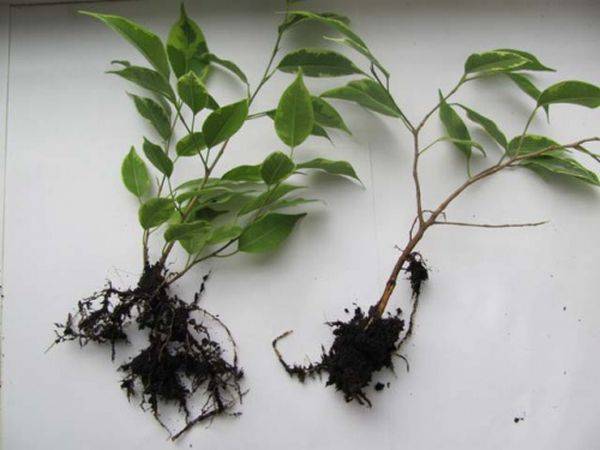

When the roots have appeared on the cuttings (this usually happens after about a month), it is time to transplant them into a permanent pot (of course, ficuses can grow very large in houses, so after a while a transplant will still be needed). The soil for a young plant should also be light, especially if the shoot has taken root in water before. Drainage should be good; expanded clay can be used for it. Some people recommend trimming roots that are too long.
The soil must be pre-moistened. Having transplanted the plant, the earth is slightly tamped and watered again. As with the method of rooting cuttings in the ground, at first, the sprouts may need greenhouse conditions.
The fact that the reproduction of indoor ficuses was successful will be signaled by new leaves.
Why can you keep
Ficus Benjamin accumulates positive energy in the room where it is located. He is a tireless worker in energy purity at home. All the negative is absorbed by its elastic leaves.
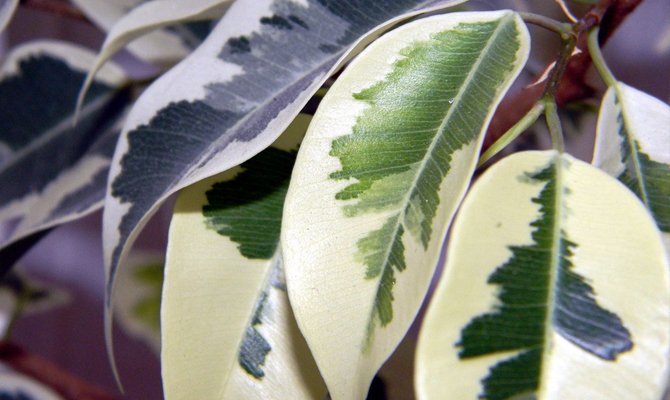

A pretty tree brings financial well-being to the house. Bury a coin in a pot, take care, water the plant and with its growth, your income will also grow. Feng Shui experts say that ficus gives the house peace and comfort. Almost every Chinese has such a tree.
In order for the ficus to bring happiness, it must be given. True, for this you must give several coins, and an odd number.
Growing ficus from seeds
When is it better to sow ficus seeds
For sowing ficus seeds, the period from early February to late April is preferable: at this time, all living things begin to awaken after winter dormancy.
How to prepare ficus seeds for planting
Having bought seeds in a specialized store, you should carefully study the instructions, because the selected variety may have special requirements for planting conditions. But most ficus seeds are sown after preliminary soaking in growth and root stimulants. Soaking promotes the awakening of the seed, and the nutritional composition activates life processes, stimulates the strengthening of immunity, and ensures better plant survival. As stimulants, you can use ready-made preparations ("Epin", Zircon "," Heteroauxin "," Kornevin "and others of similar action) or prepared independently from aloe or honey juice.
Capacity and soil for sowing ficus seeds
It is convenient to use wide, but not very deep pots or containers with drainage holes as a planting container.
Planting substrate:
- Purchased - special for ficuses, diluted with sand 2: 1;
- Any ready-made soil with neutral acidity or slightly acidic, with the addition of sand in the same ratio;
- Collected independently from leaf or turf soil (2 parts), peat (1 part), compost (1 part) and sand (1 part)
The substrate is light, loose, breathable, and moisture permeable. Consistency - homogeneous, fine, crumbly.
How to sow ficus seeds correctly
Drainage is poured into the container (more often it is small expanded clay), the top is covered with a layer of ready-made substrate - so that at least 3 cm remains to the edge of the pot. Seeds are spread on the moistened and slightly tamped soil. Since the seeds of ficuses are very small, it is easier to "take" them with a moistened toothpick: dip the toothpick in water (a solution in which the planting material is soaked, or settled water) and "hook up" the seed to the water. They are laid at a distance of 3 - 4 cm, so as not to injure the seedlings during the subsequent dive.
Ficus Benjamin: signs and superstitions
Especially superstitious growers give each plant magical properties.And in this regard, the ficus Benjamin has a bad reputation: he is considered a muzhegon, a persecutor of men. It is believed that the woman in whose house this handsome man is growing has little chance of marriage.
And if a man first appears in the house, and then a ficus, the plant will drive out a competitor, having previously ruined his character. Only the Slavs thought so negatively about the ficus, and the inhabitants of other countries, for example, Thailand and China, attribute strictly opposite properties to this plant and see it as the keeper of the family and home.
How to propagate ficus with a leaf
Next, let's figure out how the ficus reproduces with leaf plates. Let's talk about how simple and effective this method is.
Cutting the cutting
This option is great for small young plants, as you do not need to cut off large cuttings, depriving the aerial portion of a significant amount of leaves.
It is enough to cut off a leaf or several leaves together with a part of the internode. That is, the cut will pass along the knot, while you also need to make an oblique cut in order to increase the area for the formation of the rhizome.
As in the case of lignified cuttings, the ficus should be propagated with leaf plates in the spring season, so that the plant has time to take root and grow.
In the case of leaves, we have a smaller aerial part, so it is better to cut the cuttings in early spring.
Rooting process and planting
Immediately after separation from the mother plant, we put the cutting in water for several hours to wash off the juice, which, as in the case of lignified cuttings, will be released in a sufficiently large amount.
Next, it is imperative to dip the stalk into a root growth stimulator, since it is not possible to manipulate the incisions, due to the lack of a sufficient lignified area.
After the stimulator, we land. In the role of a container, a shallow pot that has a small diameter is suitable.
It must be filled with the same soil mixture as when planting a lignified cuttings (peat, sand, vermiculite). You need to deepen to the leaf petiole.
Next, abundantly moisten the substrate from a spray bottle, and cover the flowerpot with a film or a cut bottle. The temperature is maintained within + 25 ... + 26 ° С, and the humidity is 75-80%.
Such a stalk will begin to take root in 20-30 days, after which the active formation of new leaves will begin.
Where it is not desirable to put ficus
According to folk omens, there are places where the ficus in the house will not be able to maximize its positive properties:
- Far away from the window
- North facing window
- It is also undesirable to put it on a western window sill.
It will be difficult for the plant to grow in these places, it will spend all its energy on maintaining its life and will not be able to help you.
Remember that any plant is alive and how you treat it, so it will help you with its energy. According to signs, the more you take care of the ficus, the easier it will be for you to live in your house. Quarrels with a loved one will pass and life will go well.
Still have questions about ficuses? Can't decide whether to keep it in the house? Ask them in the comments and I will definitely answer you.
Let your flowers bring joy and happiness to your home.
We stimulate rapid growth and root formation
In the callus tissue of the ficus, the origin of roots occurs, which, with mechanical damage to the stem, forms a powerful root system. For the formation of callus, several small cuts are needed on the stem, layering before burying into the ground.
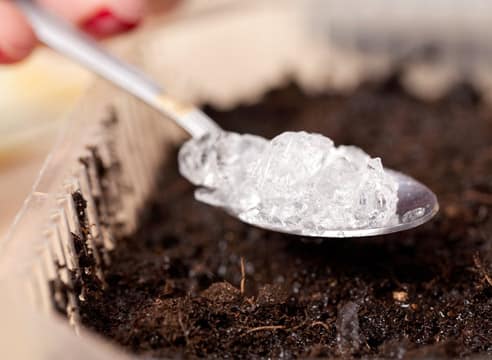

Plant feeding
For better flower growth, it is necessary to use chemical fertilizers, which improve the formation of the root system of the seedling. Treatment with growth stimulants must be done by soaking the shoot in a solution before planting, or treating the cut with a powdery preparation.
Growing a new plant from a leaf
Related Videos
Ficuses from seeds. Part 1. [Hope and Peace]
![Ficuses from seeds. Part 1.[Hope and Peace]](https://bgn.imadeself.com/wp-content/uploads/fikusy-iz-semyan-chast-1-nadezhda-i-mir.jpg)
![Ficuses from seeds. Part 1. [Hope and Peace]](https://bgn.imadeself.com/wp-content/uploads/fikusy-iz-semyan-chast-1-nadezhda-i-mir.jpg)
Ficus. How to grow ficus from seeds? House of seeds Unpretentious indoor plants Ficus rubber-bearing Sowing seeds of indoor plants. Jacaranda and sacred ficus. [Hope and Peace] FIKUS BENJAMINA FROM SEEDS GROWING
X
We are rooting cuttings in the substrate ...
You can plant a ficus stalk in a pot of soil immediately after cutting and cover it with something transparent. But in this case, it is difficult to notice accidental rotting of the cutting.
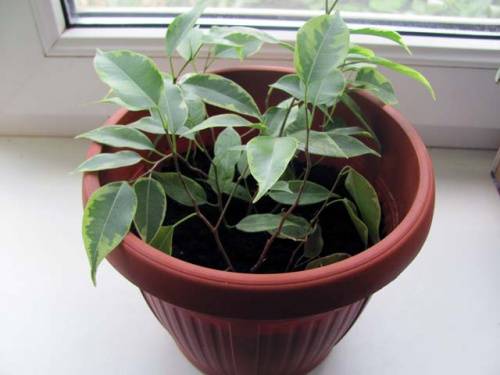

I planted the cuttings left over from pruning the ficus in one pot.
Throughout rooting, new growing leaves should appear at the top of the stem, this indicates that the cuttings have taken root. If the stalk begins to shed its leaves and the growing point dries up, then it is unlikely to take root and simply dry out.
It is not necessary to ventilate more often and keep it under cover for a long time, monitor the humidity (spraying), do not overmoisten the soil, the temperature is 23-25 degrees.
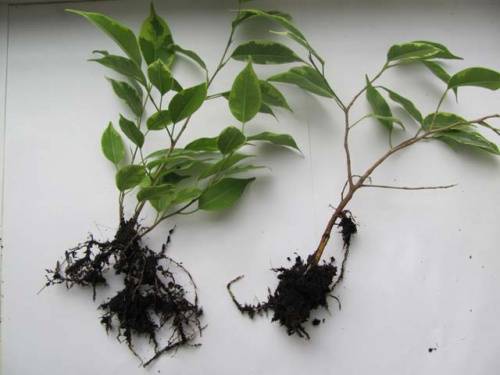

Almost all ficus cuttings gave roots after 3-4 weeks, which can be planted in pots with loose and fertile soil. Moreover, if now the growing moon is the time.
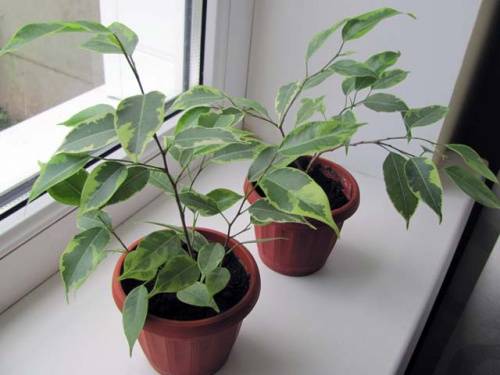

After another 2-3 weeks, the growing leaves are clearly visible. Young ficus plants turned out to be quite lush with lateral outgoing shoots.
You can take two or three cuttings of the same size and connect them together more beautifully, securing the stems in two places (from the bottom and closer to the middle) with a wire and plant them immediately in a pot. So the bush will grow faster and the trunk will become thicker. The tree will grow together over time and the wire can be removed.
As a rule, ficuses reproduce at home easily and quickly, grow well enough and delight their owners. The plant is so beautiful and unpretentious to care for that absolutely anyone can grow it. Variegated varieties of ficuses need more lighting so that the leaf does not lose its color and variegation, of course not direct sunlight, but still.


This type of ficus is considered the most attractive member of its family. It is appreciated for its dense branching crown and variegated leaf color. Such high decorative properties of the plant push florists to reproduce Benjamin's ficus at home. After all, I really want to decorate every room in the house with it. It is not difficult to do this, the main thing is to remember the basic rules of this procedure.
Among amateur flower growers, there is an opinion that independent cultivation of indoor flowers is a complicated procedure and is available only to experienced gardeners and in special greenhouse conditions. In practice, not everything is as problematic as it seems.
The easiest way to get another Benjamin's ficus is to propagate by cuttings. It is better to carry out this procedure in the spring or at the very beginning of summer. If you can create comfortable conditions for the plant, then you can harvest cuttings in the fall. But then you will need to pay a lot of attention to the ficus.
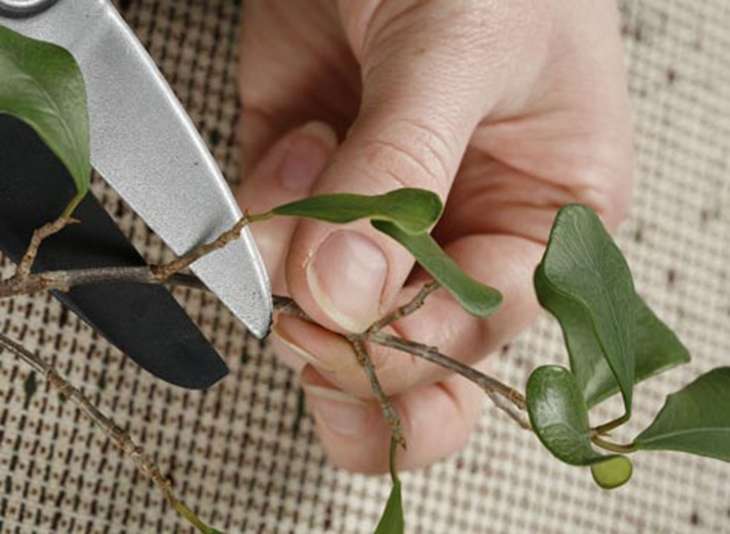

The breeding process begins with the correct preparation of the material. Branches are chosen as cuttings, the bark on which has already hardened. They are cut obliquely with a sharp knife. In this case, the height of the shoot should not exceed 15 cm. It is better to remove large leaves on the branch, and leave the top three. In order for root growth to begin faster, it is necessary to remove the protruding juice from the cut. To do this, it is enough to rinse the cut with water.
Advice! To stimulate root growth, you can use special preparations, for example, Kornevin. They are treated with a stalk before planting according to the instructions on the package of the product.
After the cuttings are prepared, they are placed in conditions favorable for root growth. It can be water or a special substrate. If you decide to use water, then the sequence of actions will be as follows:
- Pour water heated to a temperature of 36 degrees into a small container.To prevent decay of the resulting roots, you can add an activated charcoal or aspirin tablet.
- Dip the bottom of the cutting into the liquid. Make sure the leaves stay above the surface of the water.
- Cover the container with the shoot with a transparent plastic bag on top. This will create a special microclimate for the plant. The bag needs to be lifted every day to give the plant fresh air. Top up with water if necessary.
- Place the container with the handle in the light. In this case, it is necessary to avoid direct sunlight.
The root formation process takes two to four weeks. After that, it will be possible to plant young plants in a permanent place.
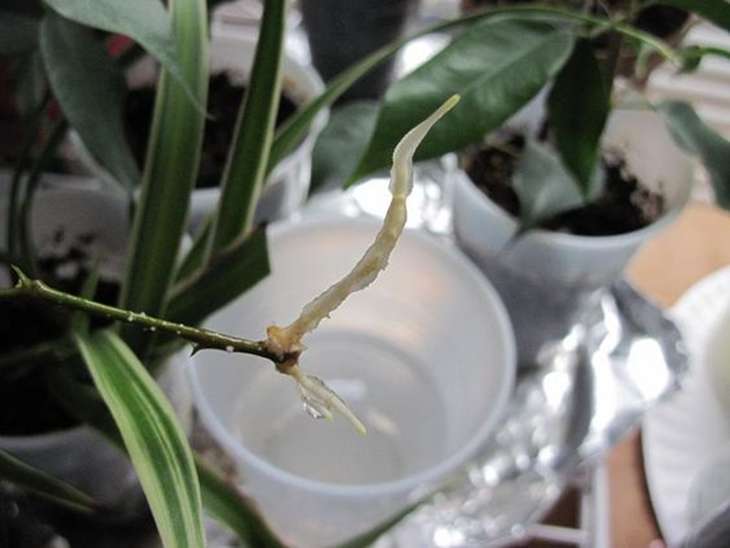

Another way to activate root growth on the cuttings is to place them in a special substrate. In this case, you must adhere to the following recommendations:
- To prepare the substrate, you need to mix the soil for ficuses, peat and a little sand. Place the resulting mixture in a pot.
- The shoot is buried in three buds, no more. The soil must be watered and slightly compacted.
- Cover the container with the sprout with plastic wrap. Move the pot to a bright place.
Advice! To speed up root formation, the cuttings are kept warm. To do this, simply place them closer to the radiator. Only after a strong root system has formed, the plant is transplanted to a permanent place. Propagation by cuttings will allow you to grow powerful and healthy ficuses.
If you want to get a lot of young plants, then a leaf of the mother ficus can be used as planting material. Choose only healthy leaves for propagation. They are cut so that the knot is not damaged. Try to keep as much internode intact as possible.


To minimize evaporation of moisture from the surface of the sheet, roll it up with a tube and fix it with a rubber band. Place the leaf in a moistened substrate. If he loses stability, support him with a small stick.
Create a greenhouse environment for the plant. To do this, cover the container with the planted sheet with a plastic bag. The fact that a root system has formed will be evidenced by the growth of new leaves.
You can propagate Benjamin's ficus using layering. The method is suitable for those plants on which lignified shoots are present in abundance, and young shoots appear slowly.
Choose a sturdy, healthy branch. Make a ring cut in the bark. Try not to touch the wood while doing this. Treat the resulting wound with a rooting stimulator and wrap with a moistened sphagnum-based substrate. Wrap the top with a film, and fix its edge with tape.
After 2-3 weeks, you will notice the roots appear. After that, the film is removed. The seedling formed under it is separated from the mother plant and transplanted into a separate pot. The place of the cut is powdered with crushed activated carbon or treated with garden pitch.
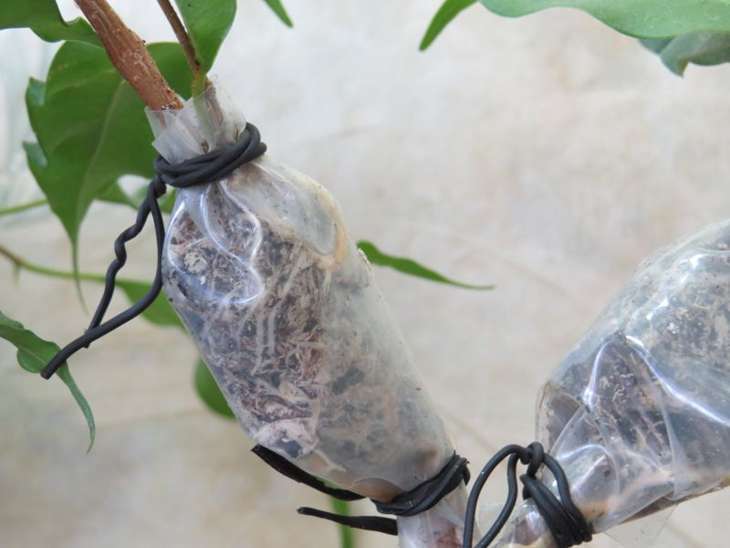

There is another method on how to propagate Benjamin's ficus - using seeds. But at home it is rarely used, since its effectiveness is low. The seeds simply do not have time to ripen.
If you decide to propagate the plant with seeds, then you will have to purchase them in a specialized store. Buy soil specially designed for ficuses there. The sequencing sequence for sowing should be as follows:
- It is recommended to soak the seeds before sowing. For this, a solution of any growth stimulator is suitable. Soak them for about an hour.
- Fill the prepared pot with soil. Lightly compact and moisturize the soil.
- Ficus seeds are buried no more than 1 cm.
- The seed pot is covered with a foil and removed to the light. The whip is removed daily to prevent mold from forming.After the appearance of the first shoots, it is removed altogether. The optimum temperature for seed germination is considered to be 28 degrees.
- Plants can be planted in separate pots when they have reached 4 cm in height.
Ficus seeds reproduce reluctantly. Experienced growers claim that only seeds produce the strongest plants with a thick trunk.
tula-


